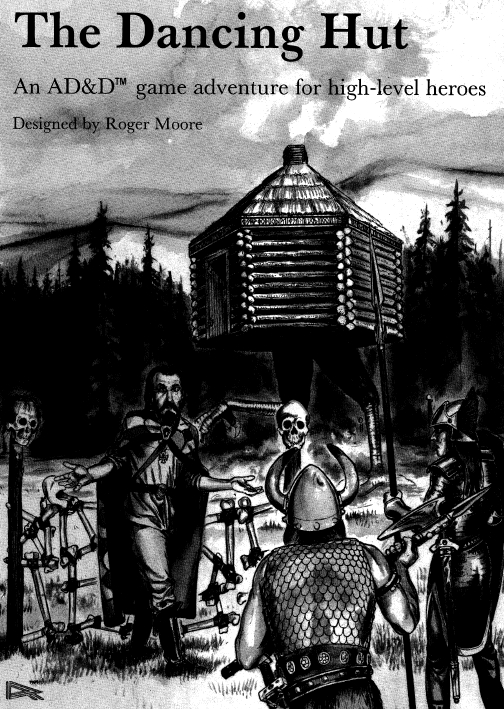

R e f e r e e ' s i n t r o d
u c t i o n
High-level adventures are hard to come
by. Every month, readers write to
DRAGON® Magazine asking for modules
in which powerful characters can test their
skills against powerful enemies, but settings
like that are uncommon.
High-level characters often run into highlevel
magic items, and the most powerful
magic items are relics and artifacts. What
follows is a description of one of the most
famous of all artifacts: The Dancing Hut of
Baba Yaga. This magical hut serves as its
own high-level adventuring environment,
and the material below suggests some scenarios
for this setting, too.
Before running an AD&D adventure
using this material, the referee should read
through this module carefully and be as
familiar with it as possible. He should pay
special attention to the Dancing Hut?s
peculiar construction. Because all referees
handle high-level adventures differently,
and because this magazine has space limitations,
Baba Yaga?s Hut is presented here in
general form. Specific details on the exact
contents of the Hut?s rooms and inhabitants
should be filled out by individual DMs, so
that no two versions of the Dancing Hut
need look exactly alike.
The Dancing Hut is designed to challenge
high-level characters to the limits of
their ability; characters below 9th level
should not go adventuring in this module.
The referee should try to avoid having
adventurers arbitrarily killed off. On the
other hand, adventurers shouldn?t receive
?Monty Haul? rewards, either.
A final note: Baba Yaga and her Dancing
Hut have been previously
described in
issues of DRAGON Magazine and the
Dungeon Masters Guide; this adventure
setting, however, contains a version that
differs from each (influenced by the author?s
research on Baba Yaga).
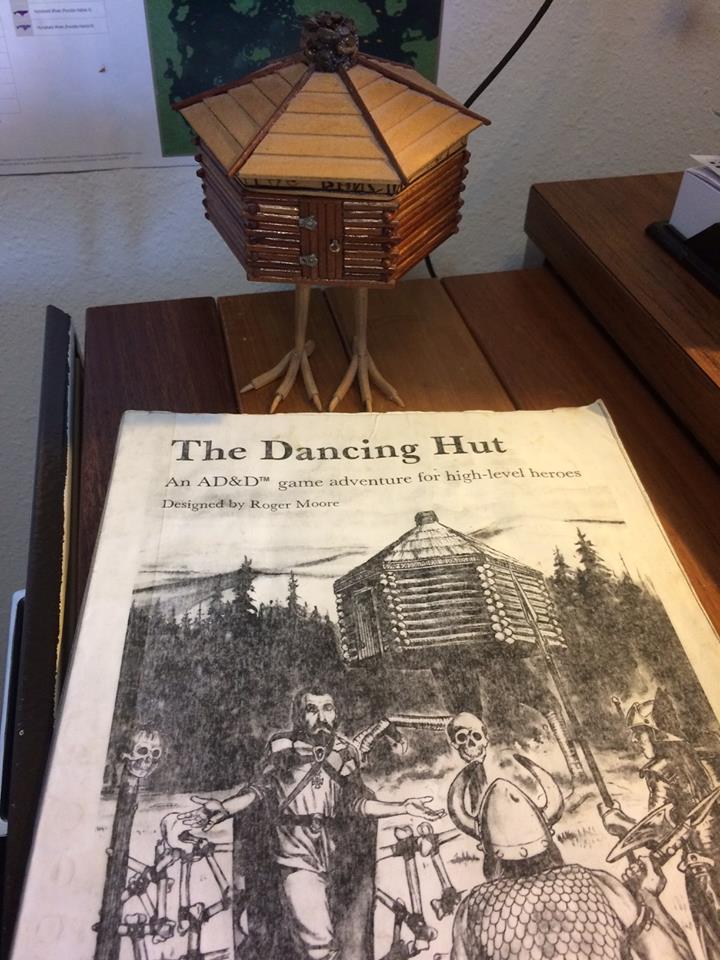
Adventuring scenarios
Baba Yaga?s Dancing Hut may be introduced
into AD&D campaigns in a variety
of
ways, depending on the goals and temperament
of the players and characters. The
scenarios below may be elaborated upon by
the Dungeon Master as desired.
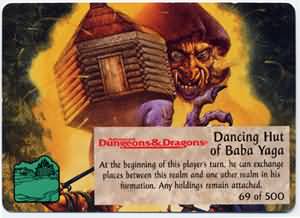
1) Baba Yaga was known to raid the
countryside around her Hut in search of
people to eat; she would kidnap them and
escape, taking the victims to her magical
Hut where she would have them prepared
for her dinner. Player characters may find
that one of their number, or a close ally and
friend, has been captured by the witch and
carried off. A rescue mission may be
launched, though no one may know at first
that Baba Yaga is the one responsible (a
rude surprise indeed!).
2) Rumors are heard that some magical
item the characters are seeking (a magical
sword, a piece of the Rod
of Seven Parts,
etc.) was taken by an ugly old woman who
rode in a huge iron kettle that skimmed
over the ground. The woman disappeared
with the item into a dark wood and has not
been seen since. Local people can point out
the way the old woman went, though characters
will have to search before finding the
Hut itself. The PCs may try stealing the
item or may bargain for it.
3) Adventurers may have heard of Baba
Yaga?s Hut, and they may wish to find and
possibly seize it. The Hut doesn?t remain in
any single location (see below); it can wander
the planes freely. There might, however,
be certain places where characters are likely
to discover it. The referee decides where
these places are, though they should be
located far from civilization and in relatively
dangerous wilderness areas. If this
scenario is used, the referee should prevent
Baba Yaga?s death at the hands of the PCs if
possible; she can then harass the characters
for many games to come.
4) Adventurers may need to consult Baba
Yaga for advice, or perhaps for a special
conjuring spell. They may seek an enchantment,
a cure, or some other form of assistance.
Baba Yaga is evil, but the characters
don?t have to be evil to consult her. See the
character description of Baba Yaga for more
information. The Hut becomes the starting
point for a series of other tough adventures.
A good DM will play Baba Yaga well to
keep her alive for many adventures. She is
a rare and valuable NPC.
The Hut?s location
According to the Russian folk tales of
Baba Yaga's Hut, this dwelling may appear
almost anywhere one could imagine. It has
been seen in tangled swamps, dark woodlands,
open fields, and even underground in
huge caverns. Usually the Dancing Hut
appears near a thick forest or in a clearing
within it.
All normal wildlife within a five-mile
radius of the Hut will soon flee, leaving
only certain magical creatures living in the
Hut that directly serve Baba Yaga. Baba
Yaga will tolerate no strong evil rivals
around her, and most intelligent beings
come to fear her more than death itself.
Legends about Baba Yaga are found across
dozens of alternate Prime Material planes.
Normal humans, demihumans, and humanoids
may flee if they are aware that she and
her Hut-have arrived in the area.
The Hut?s appearance
Baba Yaga spent much of her early life
constructing the Dancing Hut, which now
serves as her mobile fortress, home, and
helper. The Dancing Hut is a small, windowless
log cabin, hexagonal in shape, with
a decorated wooden roof. Only 15? wide
and 12? high at the peak of the roof, with a
small chimney on top, the Hut does not
appear very impressive ? except for the
12? long chicken legs coming out from the
bottom.
When first sighted, the Hut will usually
be ?dancing? by spinning about rapidly on
its feet. The Hut will make about one revolution
every six or seven seconds, with the
feet stamping the ground every half second.
If someone is entering or leaving the Hut,
the legs will fold up into a 2-foot-deep
crawlspace beneath it, so that the Hut rests
on the ground.
If so commanded by Baba Yaga, the two
huge legs can move the Hut at a very rapid
pace (48? over smooth ground, 36? over
rough terrain or swampland, 24? through
woods and mountains). About 2? thick, the
legs are treated as AC -2 and may only be
struck by magical weapons. Each leg has 45
HP, and if damaged by weapon blows will
regenerate 3 HP per round. As noted below,
the legs are immune to all magic.
When attacking (if commanded to do so,
if attacked, or under other conditions described
below), the legs strike as 10 HD
monsters, once each per round, for 4-24 HP
damage. If a leg catches a victim with a
score of 4 or more over the roll needed to
hit, the victim?s arms are pinned by the
claws, and the attacker may be crushed to
the ground for 4-40 HP damage (40%
chance), or hurled 20-120 feet away for 1d6
damage per 10? thrown (60% chance).
Thrown characters must make a saving
throw vs. paralysis or be stunned upon
impact for 2-12 rounds, unable to move,
attack, or defend themselves. Crushed
characters will be hurled away in the following
melee round.
No matter whether the Hut is spinning,
fighting, or running, the interior will remain
stable and calm, because of its extraplanar
construction. Other powers of the
Hut may be used under Baba Yaga?s direction,
and they are described in area 46
below.
The Hut itself is powerfully enchanted.
Close examination will show fine magical
runes covering every square inch of its outer
surface. The Hut?s exterior (including the
legs) is not affected by any magical spell,
and it will reflect spells cast directly upon it
(such as fireball, lightning bolt, or magic
missile), inflicting them on the caster. Areaeffect
spells not centered on the Hut will not
be reflected back, but they will not affect the
Hut, either. Though the walls are made of
wood, the Hut is immune to all forms of
fire, acid, cold, water, and lightning. Physical
attacks have no effect upon the cabin
section of the Hut.
No form of divinatory spell, not even a
wish, will reveal the Hut?s current location
(its protection resembles that offered by an
amulet of proof against detection and location).
?You?ll find it when you see it,? say
the sages.
The Hut?s environs
Once she has arrived on a new world or
land, Baba Yaga will quickly set about
constructing an enclosure to set off ?her?
territory from everyone else?s. Within a
week, she will have finished work on the
enclosure. For as long as she plans to stay,
she?ll regard it as her home. If the Hut is
encountered, refer to the material below,
which describes the usual environs.
Surrounding the Hut in a 45? wide circle
is a ?picket fence? of twenty-four sharp
stakes, each about 5? tall, with a human,
humanoid, or demihuman skull resting on
the spike. The skulls are enchanted with
magic mouth spells (see below). When the
sun disappears in the evening, a magical
flame appears within each skull that illuminates
as a light spell.
A number of special magics have been
cast around the Hut to encourage polite
visitors to enter, while preventing rude
guests from leaving. A squeaky gate about
4? high and 4? wide, made of human
bones, is set in the row of stakes around the
Hut. The gate has a low intelligence and is
aware of living beings within 10?. It will
swing outward to open, allowing anyone
who approaches to enter, but it will not
open to permit anyone to leave. If someone
tries to leave while the gate is opening to let
someone else in, the gate will bang shut,
knocking both people down on the inside of
the ?picket fence? and automatically doing
1-6 HP damage to each of them. Anyone
who oils the gate?s hinges, however, will be
allowed to enter and leave as he likes.
If someone begins to pass between the
skull-topped stakes (a logical move, since
the stakes are set about 6? apart), the two
skulls closest to him will suddenly animate,
speaking harshly in the local ?common
tongue.? They?ll warn the character to enter
or leave only through the gate. Anyone who
continues to pass between the two skulls
after this warning will be struck suddenly by
a special form of the burning hands spell
from each skull; each spell does 25 HP of
damage. Each skull may use this power
three times per day, at a 6? maximum
range. The skulls may be struck and broken
by normal weapons; they are AC 2, taking
10 HP each, but they will use their spells to
defend themselves.
Attacking the skulls at long range will
provoke them into launching fireball spells
at their attackers. These fireballs have a
range of 350 yards and effects (damage,
etc.) as if they were cast by a magic-user of
25th level. Each skull may launch two such
fireballs per day, but only one skull may fire
per round at any one attacker. Bystanders
will not be fired upon, though they may be
caught in the area of effect of a fireball
blast.
A character who teleports, levitates, flies,
or otherwise manages to ?illegally? get past
the skulls will have other problems. The
moment
the character touches the ground
inside the fence, the grass under the character's
ter?s feet will come to life and attack the
character as if an entangle spell were cast.
Bushes, weeds, and even trees will join in
the attack. The Dancing Hut will then walk
over and attack immobile characters at +4
?to hit,? and slowed characters at +2, at-
tempting to throw them out of the ?yard.?
Fire-based spells will kill the grass, though
anyone caught in the grass will also be
subject to damage from such attacks.
Entering the Hut
Once someone has made his way past the
gate (and/or the animated vegetation and
the skulls), there comes the problem of how
to get the Hut to stop spinning and settle
down to the ground. The command phrase
needed to enter Baba Yaga?s Hut can be
found by the casting of a divination,
legend lore,
limited wish, alter reality, wish, or
vision spell. The character will then know
the command phrase: ?Little hut, little hut,
turn your door to me!? The command can
be spoken in any language; the Hut will
understand immediately. The Hut will stop,
turn its door to the speaker, and settle to the
ground.
Unfortunately, the wooden door to the
Hut is wizard locked at the 25th level of
ability, though it may be opened by the
usual methods (note that the effectiveness of
dispel magic is reduced for all lower-level
characters). The door cannot be broken by
any force or power. Characters will quickly
note that the door frame is composed of
bones, and the hinges are made from human hands.
A mouth full of sharp teeth will appear in
the center of the door when anyone gets
within 10? of it. The mouth will tell the
characters (in their common tongue) to act
with proper courtesy while in the Hut and
to mind their own business. ?Spies and
thieves will be eaten,? it adds. The mouth
cannot be dispelled, and it has no other
powers.
From 5-20 minutes after a character or
party enters the front door, the Hut will rise
to its feet and begin ?dancing? again.
Characters inside the Hut may stop the
"dancing" and leave the Hut again
by the methods described in area 1 below.
The Hut?s interior
The layout of the rooms within Baba
Yaga?s Hut is highly peculiar, and may
disrupt most mapping attempts after the
first few minutes of movement. Baba Yaga
constructed the Hut around a tesseract,
a
four-dimensional figure composed of eight
normal cubes joined together along their
faces.
The floors within the Hut lie along the
different sides of the tesseract, producing
seemingly impossible (at least, from a threedimensional
point of view) room connections
within the Hut. However, it is not
necessary for referees to have a working
knowledge of four-dimensional geometry in
order to run characters through the Dancing
Hut. Each area of the Hut that rests
along a face of the tesseract is described
separately from all the others. Notations
show which other rooms can be reached
from each area, and each exit (doorway,
stairwell, and so forth) is marked accordingly
on the accompanying maps.
Spell alterations
Aside from the Hut?s immunity to and
partial reflectivity of magic, the interior of
the Hut produces some unusual alterations
in magical spells. To begin with, no magical
spell, spell-like effect, or psionic discipline
will function beyond the range of a single
area within the Hut's tesseract. A spell
cast
from area 1 toward area 2 will vanish in the
doorway between the two areas. However, a
rooms lie in one area of the tesseract. If the
spell can be cast from room to room if both
door is open to the outside in area 1, any
spells cast outside the Hut to the inside (or
vice versa) will be dispelled the instant they
enter the doorway.
However, spells cast upon one?s person or
upon an object will continue to function if
the person or object is taken from area to
area within the Hut. Thus, a mage with
invisibility would still be invisible after
going from area 1 to area 2.
The ranges of all divination-type spells
cast from within the Hut are restricted to
the area where the spells are cast; other
cannot be so examined. Peering into
planes from within the Hut is not
within certain areas as
cannot be ?spied on? from
possible, except
noted. The Hut
any source external to it, and is not open to
the Astral and Ethereal Planes, again except
within certain areas.
In addition, anyone who casts a
divination-type spell or uses a psionic power
within the Hut will be cursed in a special
way. Baba Yaga hates snoops, and has cast
magic spells that will cause an invisible
brand (shaped like a chicken?s track) to
appear on the face of anyone using divinatory
powers within her Hut, whether from
spells, psionics, or a magic item. Anyone
may see the brand using a detect magic or
detect invisibility spell, but it may only be
removed by a dispel magic or remove curse
spell (against 25th-level magic) cast by a
spellcaster of 16th level or higher. If Baba
Yaga sees someone with such a brand, she
will feel instant hatred for that person and
will do all she can to have him slain and
cooked for dinner.
Clerics and druids will not be able to
recover any spells above the 2nd level of
power while they are within the Hut, because
of its extra-planar construction (cutting
the cleric/druid off from his deity).
Magic-users and illusionists can recover
their spells normally.
A number of spells will not function or
will have altered effects if cast within the
Hut. Below is a list of unusual spell effects
produced within the Hut, with brief notes
on why the alterations occur.
A letter in parentheses after a spell name
indicates that the spell?s normal effect is
totally or partially negated, for a certain
reason:
(A) indicates the spell will not work
against any ?animal? found within the
Hut, since these animals possess magical or
paranormal powers and are technically
considered to be ?monsters.? Spells that
specifically work against ?monsters? or
fantastic creatures in general (hold monster,
for instance) will work against these beings.
(H) indicates the spell will not work if
cast upon any stone, metallic, or wooden
part of the interior of the Hut that is an
integral part of the Hut?s construction
(floors, walls, ceilings, and doors). However,
loose items such as weapons, knickknacks,
furniture, and so forth may be
affected.
(E) indicates that no natural environment
exists within the Hut (i.e., there are no
normal animals or insects that can be summoned,
no weather to be controlled, etc.),
thus the listed spell will not function.
(P) indicates the spell will not work because
no contact with or travel across other
planes can be performed while in the Hut,
unless the spell is cast within certain areas
detailed below. Contact with deities is not
possible for this reason.
Other spell alterations specific to certain
areas of the Hut are given in the area descriptions.
The descriptions of Baba Yaga
and her two ?daughters? should be consulted
to determine the effects of spells cast
against them, either within or outside the
Hut.
Cleric spells
Aerial servant -- (P)
Animate object -- (H); objects found
within the Hut may be animated, but will
never obey anyone but Baba Yaga and will
never attack anyone unless Baba Yaga so
commands them.
Astral spell -- (P)
Commune -- (P)
Conjure animals -- (E)
Control weather -- (E)
Detect evil/good -- The Hut has no
alignment, though the inhabitants do.
Detect magic -- The entire Hut radiates
magic so powerfully that even non-magical
or weakly magical items will show up as
?strong? sources of magic, making this
spell useless.
Dispel magic -- This will function normally,
though it will not affect the powers of
the Hut itself. Spells cast by characters
within the Hut may be dispelled. Check
Baba Yaga and her ?daughters? for the
appropriate spell levels they operate at.
Divination -- (P)
Earthquake -- (H)
Exorcise -- Has no effect upon the Hut,
though it may break charms, curses, and
the like cast upon characters.
Find the path -- This spell will produce
meaningless results if cast with the intent of
finding something in any area of the Hut
from anywhere outside that area. The reverse,
lose the path, functions normally.
Find traps -- All doorways leading from
one area of the Hut to another (crossing
faces in the tesseract) will be detected as
traps by this spell (as alteration magic).
Gate -- If cast within the Hut, and if
Baba Yaga is present, it will alert her to the
presence of the spellcaster and his exact
location instantly. Baba Yaga will not be
summoned to the caster, but will come on
her own to investigate, fully prepared.
Holy/unholy word -- This spell will not
cast anyone back to his home plane, though
it works normally otherwise; it will affect
opposite-aligned beings just as it does everyone
else.
Insect plague -- (E)
Know alignment -- See detect evil/good.
Locate/obscure object ? See commentary
on find the path.
Plane shift -- If cast within the Hut,
the
plane shifted character(s) will be randomly
transported to one of the 48 areas across the
tesseract in the Hut. The area arrived at
may be determined by rolling a d4 and a
d12. If the d4 rolls a 1, the characters arrive
at room 1-12; if a 2 is rolled on the d4,
room 13-24, and so forth, rolling the d12 to
select the exact room. The exact point
within an area at which the characters
arrive may be chosen by the referee as
desired.
Speak with animals -- (A)
Spiritual hammer -- (P)
Stone tell -- Any stone that forms a part
of the interior of the Hut will refuse to
cooperate with characters who request
information from it, instead insulting them
intolerably and calling for help from Baba
Yaga for the spell?s duration, unless otherwise
dispelled.
True seeing -- No ethereal, out-of-phase,
or astral beings or objects will be seen, since
the Hut does not connect to those planes.
Word of recall -- (P)
Druid spells
Animal friendship -- (A)
Animal growth/reduction -- (A)
Animal summoning (any) -- (A)
Animate rock -- (H); see cleric spell
animate object.
Anti-animal shell -- (A)
Call lightning -- (E)
Call woodland beings -- (E)
Chariot of Sustarre -- (P)
Charm person or mammal -- (A)
Commune with nature -- (E)
Conjure earth elemental -- (E)
Conjure fire elemental -- (E)
Control weather -- (E)
Creeping doom -- (E)
Detect magic -- See cleric spell.
Detect snares & pits -- This spell will
only locate simple pit traps within the Hut
(if any are present).
Dispel magic -- See cleric spell.
Heat metal -- (H)
Hold animal -- (A)
Insect plague -- (E)
Invisibility to animals -- (A)
Locate animals -- (A)
Pass plant -- (P); works only if transport
ing within an area in the Hut, not intending
to leave it.
Predict weather -- (E)
Speak with animals -- (A)
Stone shape -- (H)
Summon insects -- (E)
Transmute metal to wood -- (H)
Transmute rock to mud -- (H)
Transport via plants -- (P); see pass
plant.
Turn wood -- (H)
Warp wood -- (H)
Weather summoning -- (E)
Magic-user spells
Animal growth/reduction -- (A)
Anti-magic shell -- Will not prevent any
functions of the Hut from working (i.e.,
walking, attacking, etc.); in addition, if this
spell?s area of effect touches a doorway
leading to another face of the tesseract, the
doorway vanishes completely for 2-24
hours, replaced by an impenetrable gray
wall. The doorway will reappear after the
2-24 hours.
Astral spell -- (P)
Bigby?s hand (any) -- The hands will be
dispelled if they are made to cross a doorway
from one area of the tesseract into
another.
Blink -- (P)
Cacodemon -- (P)
Cloudkill -- This spell will not spread
into any other areas in the Hut except for
the one in which it is cast. The cloud cannot
cross into other faces of the tesseract.
Conjure elemental -- (P)
Contact other plane -- When cast, this
spell will drive the spellcaster instantly
insane with a random insanity
from the
DMG; unless given a remove curse spell,
the mage will be insane for 4-48 weeks.
Nothing else will be gained from this spell.
Baba Yaga may use this spell normally in
the Hut.
Control weather -- (E)
Detect evil/good -- See cleric spell.
Detect invisibility -- See cleric spell true
seeing.
Detect magic -- See cleric spell.
Dig -- (H)
Dimension door -- (P)
Dispel magic -- See cleric spell.
Distance distortion -- (P); spell requires
an earth elemental.
Drawmij?s instant summons -- (P)
Duo-dimension -- (P)
Enlarge/reduce -- No effect upon the
Hut.
Erase -- No effect on the runes on the
outside of the Hut or on Baba Yaga?s skin.
Find familiar -- No response will come to
this summons if cast in the Hut.
Gate -- See cleric spell.
Hold portal -- No doorway within the .
Hut will accept this spell from anyone but
Baba Yaga; attempts made by other people
will fail.
Identify -- If this spell is cast upon the
Hut itself, the mage will receive but one bit
of information: this is indeed Baba Yaga?s
Hut. Nothing else will be learned.
Imprisonment -- (P)
Incendiary cloud -- See cloudkill.
Invisible stalker -- (P)
Legend lore -- See identify and note
about finding command words to enter
Hut; aside from this, nothing else will be
learned.
Leomund?s secret chest -- (P)
Locate object -- See cleric spell.
Magic mouth -- If cast upon a wall,
ceiling, or floor within the Hut, the magic
mouth will verbally abuse the caster, continuing
to do so for one round. Baba Yaga may
use this spell normally within the Hut.
Maze -- This spell will randomly shift
the victim to one of the 48 areas within the
tesseract, as per the cleric spell plane shift.
The victim will be left in the new area after
the spell?s duration ends.
Monster summoning (any) -- If any
monster summoning spell is cast within the
Hut, the spell will bring one of the following
beings from the listed area of the Hut.
I -- Manes demon (from 33)
II -- Lemure devil (from 33)
III -- Vladimir the giant cat (from 1)
IV -- Harginn grue (from 22)
V -- Piscodaemon (from 34)
VI -- Annis (from 36)
VII -- Night hag (from 19)
None of the above summoned beings will
be well disposed to the summoner, and are
not under any compulsion to obey his orders.
All beings except Vladimir will attack
at once; Vladimir will flee.
Mordenkainen's faithful hound -- The
hound so summoned will begin barking at
the player-character party, attempting to
summon Baba Yaga or her minions (the
essence of the phantom hound is drawn
from the Hut, and thus serves the Hut?s
builder). It will obey Baba Yaga?s every
command. Anyone turning his back to the
hound will be attacked. If the mage who
summoned the hound passes through a
doorway from one area (face) of the tesseract
to another, the hound will be dispelled
immediately. The hound can be
dispelled by normal means, too.
Move earth -- (H)
Passwall -- Will allow movement
through interior walls of an area, but won?t
permit movement from one area of the Hut
to any other area if travel across tesseract
faces is involved. The user cannot leave any
mapped area.
Phase door -- See passwall.
Power word (any) -- Will not affect
inhabitants of any other area (face) of the
tesseract but the area it was cast in.
Prismatic sphere -- The violet globe will
send those touching it to another of the 48
areas within the tesseract, determined as
per the cleric spell plane shift.
Project image -- Will not form an image
in any area of the Hut other than the one
the spellcaster is in.
Rope trick -- This spell will create a
temporary opening into a random area of
the Hut, determined as per the cleric spell
plane shift.
Spiritwrack -- Will function against
certain extra-planar inhabitants of the Hut
if true names are known, but not against
Baba Yaga.
Stinking cloud -- See cloudkill.
Telekinesis -- If an item is telekinesed
across a doorway leading to another area of
the Hut (in a different tesseract face), then
the spell?s effect on the object ceases.
Teleport ? See druid spell pass plant.
Tenser?s floating disk ? The disk will be
dispelled the moment it or the spellcaster
crosses a doorway leading from one area
(face) of the tesseract to another one.
Transmute rock to mud -- (H)
Unseen servant -- The servant will not
obey any commands of the caster, instead
pushing against the caster as he moves
(adding an extra 400 gp worth of encumbrance
to him) for the duration of the spell
(see Mordenkainen?s faithful hound). The
servant may be dispelled. Baba Yaga may
use this spell normally.
Vanish -- (P)
Wall of iron/stone -- If the wall created is
larger than the dimensions of the room in
which it was created, the wall will not appear
and the spell will be lost.
Wizard eye -- This spell will be dispelled
if made to cross a doorway from one area of
the Hut to another.
Wizard lock -- See hold portal.
Illusionist spells
Astral spell -- (P)
Conjure animals -- (P)
Detect invisibility -- See m-u spell.
Detect magic -- See cleric spell.
Dispel illusion -- Check Baba Yaga?s
spell level (as per dispel magic) if this is
used against her magic.
Fog cloud -- See m-u spell cloudkill.
First level magic-user spells -- See the
appropriate spell descriptions.
Magic mouth -- See m-u spell.
Maze -- See m-u spell.
Prismatic spray -- The violet ray will
hurl affected characters at random to one of
the 48 areas within the Hut, as per the
cleric spell plane shift.
Prismatic wall -- The violet curtain will
work as per the note under prismatic spray
(see also m-u spell prismatic sphere).
Rope trick -- See m-u spell.
Summon shadow -- (P)
Vision -- See m-u spell contact other
plane.
Wall of fog -- See m-u spell cloudkill.
In addition to the above, any new spells
being used in a campaign should be evaluated
by the DM to determine any changes
in their effects prior to running this adventure,
using the above spell effects as a yardstick.
Past issues of DRAGON® Magazine
have presented new spells for the various
classes, but these will not be detailed here.
The Dancing Hut cannot be destroyed by
any magic the player characters bring
against it. Even powerful items like a rod of
cancellation or sphere of annihilation should
have a limited effect against the Hut or any
of its innate powers, as long as Baba Yaga is
alive. The Hut was built to last.
Potions: Magical potions will have the
same effects in Baba Yaga?s Hut as the
equivalent spell or psionic power (for example,
oil of etherealness and a potion of animal
control would generally be useless).
Treasure finding potions will not detect the
presence of the Hut at all, and the drinker
will be branded with a ?chicken track?
stigma as well (see spell alterations).
Scrolls: All scroll spells function the same
as the spells they are drawn from. Protection
from magic scrolls will affect the Hut as
the magic-user spell anti-magic shell,
though they may deactivate a certain item
within it or on the party and burn out (see
effects of rod of cancellation on doorways in
the Hut, described below).
Rings: Those rings duplicating spell
effects produce the same result as the spell
itself. Djinni summoning rings will not
work, as per the various summon elemental
spells, and a ring of shooting stars will not
function within the Hut, since there is no
?night? inside. Re-roll all malfunctions of a
ring of spell turning so that the wearers do
not fall into the Positive Material Plane.
Rods, staves, & wands: Devices duplicating
spell effects will produce the same
results as the spells themselves. A rod of
cancellation has no effect upon the Hut
other than eliminating doorways that temporarily
lead from one tesseract area to
another. (And in the process, destroying the
rod; see magic-user spell anti-magic shell.)
A rod of cancellation
will work against
mundane magical items, though. A rod of
lordly might cannot use its direction-finding
or depth-finding abilities. A wand of negation
has no effect upon the Hut.
Weapons, armor, & protective devices:
Generally, no alterations of the powers of
these items will occur, unless otherwise
implied by the above magical changes (for
example, plate mail of etherealness will not
allow the user to go ethereal).
Miscellaneous magic items: Many devices
will become useless when brought into
the Hut or will have altered powers. Items
duplicating spells or psionic powers will
produce effects as described elsewhere.
Those items which make use of extradimensional
spaces to store things (e.g., a
bag of holding) will not function ? except
for a portable hole,
which will open into a
random section of the tesseract (see above
for cleric spell plane shift). A mirror of
life
trapping will not function. A cubic gate,
amulet of the planes, well of many worlds,
or similar device will shift characters elsewhere
within the Hut, as described above.
Items that establish contact with one?s
deity, or that require such contact to function
(incense of meditation, necklace of
prayer beads, candle of invocation, etc.),
will not work. A talisman of pure good (or
ultimate evil) will not produce any effects. If
a book of infinite spells is left on the Prime
Material Plane while the user goes into the
Hut, the user cannot use the spells in it.
If a sphere of annihilation is brought near
the Hut, the Hut will automatically back
away from it at maximum speed once the
sphere gets within 24?. The Hut can detect
the presence of the sphere in various ways
and will seek to avoid contact with it if
possible. If contact cannot be avoided, the
Hut will attempt to plane shift to another
universe, if under Baba Yaga?s command
(see area 46); if not under her command,
the Hut is allowed a saving throw (of 3 on a
d20) against the sphere to avoid destruction
if it is touched; a successful save means the
sphere was cast into another universe, plane
shifted away.
Psionic alterations
Baba Yaga?s Hut produces alterations in
psionic powers as well as magical ones.
And, to make matters worse, the Hut attracts
cerebral parasites as
a side effect of its
planar travel capabilities. Any psionic character
within 120? of the Hut who uses a
psionic talent (attack/defense mode or discipline)
will immediately attract 2-20 parasites
to him per round. Any method used to
get rid of the parasites will last only one
round, and more will come after that. (Assume
there are hundreds hovering around
the Hut at any time, as well as dozens
within each area inside it.)
As long as characters are able to use
psionic abilities, here are the alterations that
will occur within the Hut to such talents:
Animal telepathy Generally ineffective;
all encounters within the Hut are with
?monsters,? except for those described as
exceptions.
Astral projection (P)
Clairaudience ? Not effective if attempting
to ?spy? through doorways into other
areas in the tesseract.
Clairvoyance See clairaudience.
Detection of good/evil See cleric spell
detect evil/good.
Detection of magic See cleric spell
detect magic.
Dimension door (P)
Dimension walk ? Use of this power will
cast the psionic into one of the 48 areas of
the tesseract at random (see cleric spell
plane shift), but will also stun the psionic
for 2-8 rounds, leaving him helpless.
Etherealness (P)
Molecular agitation (H); can only be
used within one area of the tesseract.
Molecular manipulation (H)
Molecular rearrangement (H)
Object reading Same result as m-u
spell identify; use of this talent will cause
the psionic to be marked with the ?chicken
track? stigma noted above, producing a
very unfavorable reaction from Baba Yaga.
Probability travel Same effect as cleric
spell plane shift.
Sensitivity to psychic impressions Any
use of this talent within the Hut will cause
the psionic to gain the ?chicken track?
stigma mentioned above. The only vision
gained will be of Baba Yaga herself, staring
into the psionic?s eyes; the psionic must
save vs. will-force spells (wisdom bonus
included) or be affected as if by a scare spell
(all races can be so affected).
Telekinesis -- See m-u spell.
Teleportation See druid spell pass
plant.
Wandering encounters
Random encounters with inhabitants of
the Hut are possible as the party wanders
through. The DM should design a ?wandering
monster? table that includes most
beings that might be met in the Hut in
general. Note that areas 12 (any room but
A and B), 14, 17, 33
(lab only), and 46
should have no random encounters other
than those listed for them. Wandering encounters
should be rolled for at the start of
every game turn (10 rounds), with a roll of
1 on a 6-sided die indicating an encounter
will take place.
Dungeon Masters may give some of the
encountered beings magical items, and
otherwise adjust the ?wandering monsters?
to suit their campaign. Some suggested
encounters (only briefly outlined) follow.
DMs should take the time to work out
encounters in detail before an adventure
begins. At the DM?s option, certain encounters
(particularly the annis maids and
various daemon servants) may be considered
?extra? beings not otherwise listed in
the area descriptions below.
Possible encounters:
1-4 annis maids on an errand, from
41.
1 arcanadaemon with 1-2 yagnodaemon
assistants, visiting the Hut on business with
Baba Yaga.
1-4 derghodaemons from 48,
carrying
heavy crates full of treasure or garbage.
4-16 diakka, summoned from Hades,
holding brooms and dustpans (cleaning the
Hut).
1-3 greenhags from 11, taking
a stroll
through the Hut.
1 night hag, visiting Baba Yaga
from
Hades, with 2-8 hordling servants.
1-4 lost and demoralized captives, who
escaped from an annis guardian.
Most of
them will be O-level humans; some might be
adventurers.
Natasha the Dark, with 3-6 Type
III
demons as servants, from 15.
Elena the Fair, from area 17; 50% chance
she is wandering alone, and 50% chance
she is with Vladimir the giant cat (from 1).
Baba Yaga: 50% chance she is alone,
30% chance she is with a nycadaemon,
20% chance she is advising a lich,
mage, or
archmage visitor.
Area descriptions
Following are descriptions of the 48 different
areas within the Hut;'s tesseract; each
area may contain one or more separate
rooms, and each room may be of wildly
variable size and shape. Though a tesseract
has faces of equal size, Baba Yaga?s use of
teleporters within the tesseract allows this
variability. Gravity is normal in all rooms.
Each area is connected to other areas by
special trans-planar gates. Most of these
gates look like normal doorways, though
some are built into staircases going up and
down between areas. Unless certain spell
effects tell them otherwise, characters will
probably not know when they are crossing
from one area to the next. If Baba Yaga, her
cat or servants, or her two ?daughters?
approach any doorway in the Hut, the door
will automatically open for them and close
one segment after they pass. All other beings
(including characters) must force the
doors open using normal strength rolls.
In certain areas, secret doors have been
built into the floors and ceilings. Many of
these open directly into other areas, though
no ladders or stairways are around. These
portals are enchanted so that if Baba Yaga,
her servants, or her two ?daughters? call
out a command word (?Up!? or ?Down!?)
when standing next to the portals, they will
receive a levitate spell for 1 round that
automatically takes them up or down safely
to the next floor. However, this will not
work for any other characters.
Regardless of the weather conditions
outside, the interior of the Hut (in all areas,
unless otherwise stated) is pleasantly warm
and dry. Unless stated otherwise, most
rooms in the Hut appear to have walls
made of dark, stony material. The DM may
add extra details as desired.
The following abbreviations are used in
the room descriptions: CH = ceiling height;
IL = illumination; CL = continual
light
(magic-user spell, 25th level); ND = effect
cannot be dispelled. Many area descriptions
contain map references as capital letters; the
referee should use the text and the map
simultaneously to get the fullest possible
understanding of the appearance or configuration
of an area.
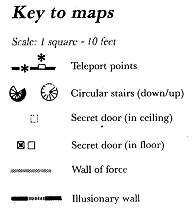
1) Hut -- CH, 7 flat; IL, oil lantern on
table.

The first room entered in the Hut resembles
an old peasant woman?s hovel; the floor
is packed earth, with wooden walls and
ceiling rafters. A small wooden table with
one chair sits in one corner of the hexagonal
room with a washbasin beneath it; a woodburning
stove (A) with a chimney rising to
the center of the ceiling rests in the opposite
corner. Near the stove is a small straw-filled
mattress with a worn quilt over it. Clothes
pegs, shelves, bread boxes, combs, eating
utensils, and sewing supplies complete the
room?s contents.
A secret door on the floor is covered by
the washbasin under the table; wooden
stairs lead down to a cellar (area 19). A
wooden ladder (B) is fixed against the wall
next to the table, apparently leading up to
an attic. If someone climbs it, however, he
will pass through a gateway and come out
through the floor in area 7. On the wall of
the Hut opposite the front door is another
door made of old wood; it leads into area 2.
Several peculiar things will be noticed if
characters take the time to explore this area.
The stove automatically reduces all nonliving
materials placed inside it to onefourth
normal size, until the material is
removed. A basket next to the stove contains
charred goblin, elf, and human bones
jumbled together; all have marks on them
as if a creature with sharp teeth gnawed
away what meat they had.
The only live encounter here is with Baba
Yaga's cat, a large gray tabby named Vladimir
(treat as an 18 HP giant lynx,
neutral
alignment). Vlad uses limited telepathy to
communicate with intelligent beings within
10? of him, and can detect lie with 99%
accuracy. He can hide in shadows and move
silently with 99% success, and can surprise
opponents on a roll of 1-5 on d6. Vladimir
will speak only to those who treat him well,
and will ignore all others. He can offer
limited advice to the PCs (as much as the
referee wants to impart).
If not forcibly held open, the front door
will shut on the round after the last character
enters, and will be wizard locked again.
Any successful attempt to open the door
from the inside after this will cause the Hut
to stop ?dancing? (if it had started) and
lower to the ground in the same round the
door wasopened.
2) Entry Hall -- CH, peaked roof along
long axis of room, 60? high at center, 30? at
sides; IL, 3 CL spaced evenly along roof.
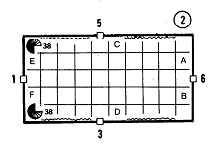
The walls, floor, and ceiling in this grand
room are made from fine oak, with four 15?
x 30? tapestries hanging from the walls.
The tapestries are woven from gold, silver,
brass, platinum, mithral, copper, and adamantite
wire, depicting scenes of great
palaces from other worlds and lands. The
value of each tapestry is staggering (40,000
gp each). Two circular stairwells descend to
area 38; the four doors here connect to
areas 1, 3, 5, and
6.
Six translucent, glass-like colored statues
stand near the doorways in this area. All of
the statues will animate if any attempt is
made to steal the tapestries (and they can
also animate upon Baba Yaga?s command).
The statues are AC 0, 9 HD, 40 HP, MV
12?, and may strike once per round at
opponents. The attacks differ from statue to
statue, duplicating the effect of a prismatic
sphere spell according to the each statue?s
color. Statue A is red, B is orange, C is
yellow, D is green, E is blue, and F is indigo;
thus, a strike from C would do 40 HP
damage, one from D would cause the victim
to save vs. poison, etc. The statues are
immune to all magical spells except the
spells that negate the effects of the individual
colors of a prismatic sphere, and if a
statue is struck by the right spell, it is destroyed.
Statue A would be destroyed by a
cone of cold, for instance, but this spell
would not affect any other statue. Unless
Baba Yaga commands them to do so, the
statues will not leave the room.
Attempts to remove the tapestries from
the walls will cause them to unravel and be
destroyed. Roll a bend bars/lift gates chance
for each character trying to pry a tapestry
free; if the roll succeeds, the tapestry leaves
the wall and falls apart in 1-4 rounds. The
value of the unravelled wire is 5,000 gp per
hanging. Only if a mending spell is cast
upon a tapestry while it is unravelling will it
be preserved.
3) Audience Chamber -- CH, 20? over
square floor, 15? over throne level; IL, wall
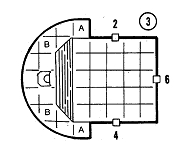
This chamber is used by Baba Yaga when
hearing petitions from mortals who are not
spellcasters of ?name level? (11th level for
behind throne radiates red light (ND).
magic-users, 12th level for druids, etc.).
Being exceptionally cautious (and somewhat
paranoid), the witch has placed a magically
enlarged trapper on the square
floor before
her throne. The trapper covers 2,500 square
feet, but is otherwise like others of its kind;
it has 83 HP. It will only attack on Baba
Yaga?s command, unless an offensive spell
or physical attack is directed against it.
Stairs lead up to the throne level, 5?
above the floor. The throne is made of a
solid block of red quartz, extensively engraved
with runes and symbols of magical
power. The throne is immune to blows and
magic, and is fixed to the floor as well, so
treasure hunters cannot take it. The wall
behind the throne is red crystal glassteel,
and radiates light from its surface.
Flanking the throne on either side are two
animated hill giant skeletons (HD 9, HP 40
and 52, 2-16/attack, otherwise as normal
skeletons) at the two points labeled B. The
skeletons cannot be turned by clerics, because
of Baba Yaga?s enchantments, and
will only obey her. The skeletons, however,
are not the major guardians of the throne:
polymorphed into the forms of two ivory
statues at the points labeled A are two mezzodaemons
(85 and 97 HP) that will attack
anyone who attacks Baba Yaga; the
daemons will use levitation to avoid being
caught by the trapper if necessary.
If Baba Yaga is not present, there is a
60% chance that one of the mezzodaemons
will have polymorphed itself into her form
and will be sitting upon the throne. It will
act like her until attacked, and will generally
hear petitioners out, tell them to go
back to area 1, and then leave the throne
room and report to Baba Yaga.
The three doorways in this room connect
to areas 2, 4, and 6.
4) Art Gallery -- CH, each room (A-I) is
domed, 20? high at center and 10? on sides;
IL, 1 CL in ceiling of each room.
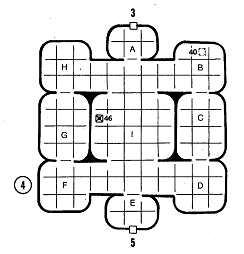
Numerous works of art from different
universes hang or stand in the nine chambers
in this area. Chambers A-H each contain
2-7 paintings or tapestries, and 1-4
statues (most of human subjects, but a few
of nonhuman races). Some of the paintings
and statues have magical powers, and may
be developed by the DM as desired (some
might be NPCs affected by flesh to stone).
The large chamber, I, has 16 paintings and
six statues, some magical (as noted above).
Wishing to use guardians that would not
damage the artwork, Baba Yaga has caused
four spectres (HP 36, 38, 41, and 47) to be
forever bound to this area; they cannot
leave it, and will attack anyone except the
residents of the Hut (Baba Yaga, her
?daughters,? and her servants) and creatures
from the Lower Planes like night hags.
Aside from the doors to areas 3 and 5,
two secret passages are present here. Chamber
B has a secret door in the ceiling that
may only be opened if a passwall or phase
door is cast upon it; the door is detectable
only using magical means (true seeing or
true sight spell, gem of seeing, etc.). The
door leads into area 40.
A concealed door is hidden in the floor
under an iron statue of the Hut in Chamber
I. The statue weighs several hundred
pounds, and requires a bend bars/lift gates
roll to push aside. The statue will animate
and step aside if Baba Yaga commands it,
but if anyone else tries to move it, it will
attack as an iron golem in every
respect
(AC 3, MV 6?, HP 80, kicking once per
round for 4-40 damage, and pouring gas
from the Hut?s doorway every seven
rounds). The door drops into area 46.
5) Recreation and Dance -- CH, each
room (A-E) is domed, 15' high in center
and 10? high along walls in rooms A-D, 25?
hemisphere over E; IL, 1 CL centered in
ceiling in each room.
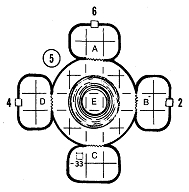
Each room in this area is devoted to a
different form of game or hobby. Room A
contains sewing materials and a small loom;
B has assorted card and trinket games; C is
a dressing room for dancers and actors, and
D contains various musical instruments.
Room E has a lowered floor in the center,
3? down, for dancers and actors to perform
upon. The entertainers who perform here
are usually ones who have been kidnapped
by Baba Yaga, and they must please her
with their performances in order to be
released (poor performers are eaten).
The curtains that separate each room are
enchanted to deaden all sounds passing
through them, effectively isolating the
rooms during musical performances or
dances. Several magical items collected
from various planes and worlds may be
found here, but when rooms A, B, and D
are not in use, permanent
illusions are cast
over them, making them appear to be storage
rooms with nothing valuable in them. If
she hasn?t been encountered elsewhere,
there?s a 20% chance of meeting Elena the
Fair (see area 17) in room D; she will be
friendly, but won?t permit the theft of any
items.
The normal doorways here lead to areas
2, 4, and 6; a secret
door detectable by
normal means is in the ceiling in room C,
and leads to area 33.
6) Grand Throneroom -- CH, vaulted
ceiling 60? high along long axis, down to
20? high at sides, supported by pillars; IL,none except for 1 CL
(red) over throne, 30?
above floor.
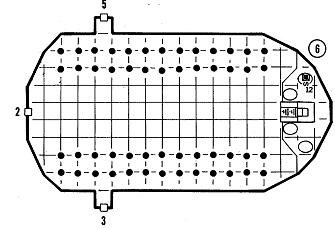
The Grand Throneroom is an aweinspiring
structure, with floors and walls
composed of black marble with veins of
gold. The pillars lining the room are clear
purple glassteel. The dark, starry
ceiling is
made of lapis lazuli, and has gems worked
into fine gold decorations around it. Doorways
to areas 2, 3, and 5
lead out from it.
At the head of the room is a raised dais 5?
high, upon which four titanic human skulls,
each 10? across, rest facing the opposite end
of the hall. The skulls are made from carefully
fitted sections of ivory, rendered hard
as steel through enchantments. Centered
between the skulls is the great throne of
Baba Yaga, rising an additional 10? above
the dais, reachable by a staircase.
The giant skulls are each AC -2 and have
40 HP apiece. Upon Baba Yaga?s command,
each may fire a ray ofparalysis (as
the wand) up to four times per day. In
addition, once per day each of the two skulls
closest to the throne may form a symbol (as
per the magic-user spell) on its forehead,
visible to anyone within 60?. One of the
skulls has a secret door set in its side; on the
floor inside the skull is another secret door,
detectable only by magical spells or devices.
This door drops down into area 12.
The throne is composed of a single block
of black jet stone encrusted with rubies and
amethysts; its value is beyond reason or
counting. The throne is raised an additional
five feet above the dais level, with a series of
steps leading up to it. Baba Yaga?s name
appears on the throne in letters made from
large rubies, each worth tens of thousands
of gold pieces. The throne, however, cannot
be damaged and the stones cannot be removed;
anyone attempting to damage the
throne must make a saving throw vs. death
magic or die instantly.
The throne has other powers that can be
activated by Baba Yaga?s command. Three
times per day it can generate a globe of
invulnerability at the 25th level of power,
and it can generate a prismatic sphere once
per week upon command. The throne may
cast fear (as the wand) once per turn, and
rulership (as the rod) once per day. If anyone
but Baba Yaga sits upon the throne, he
will be instantly inflicted with megalomania
and paranoia (as per the descriptions
in the
DMG insanity rules), and will receive 5-30
HP of damage as well (saving throw for half
damage; insanity comes regardless).
7) ?Attic? -- CH, 8? flat; IL, none.
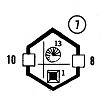
The attic looks very much like what one
would expect to see, except that no chimney
rises through it from the stove (the chimney
is in area 1 ?s part of the tesseract), and the
ceiling isn?t pointed like the roof of the Hut.
Scattered about the floor of the attic are
trunks, chests, and boxes full of old clothing,
used-up wands and burnt-out amulets,
and the other useless paraphernalia that an
ancient witch might accumulate. A spiral
stair leads up to area 13, a trap door leads
down to area 1, and normal doors lead to
areas 8 and 10.
One of the trunks has a guardian familiar
upon it which has received several extra
enchantments. It will fight at a hasted speed
if it attacks, always doing the maximum
possible damage; it receives maximum hit
points in all incarnations; and it can see
invisible objects. The trunk it guards contains
20-80 gems, 20-50 jewels, and three
magical items (of the DM's choice). Beneath
this treasure is a silk cloth covering
up a symbol of insanity inscribed on the
trunk?s bottom.
8) Bestiary -- CH, 10? flat; IL, ceiling
gives off soft light (as light spell) over area
for 12 hours/day, then drops to almost total
darkness for 12 hours (ND).
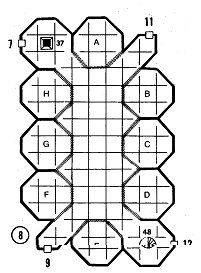
Eight octagonal cages are in this room,
each separated from the other and from
onlookers by walls of force that complete
their octagonal shapes. The walls of force
may be removed or raised with a brief
command phrase, which names the creature
to be captured or freed; however, only
magic-users of 12th level or higher will be
able to use such commands successfully.
Each cage will magically create food and
drink for its inhabitants, freshen their air,
and otherwise keep the creatures alive.
These cages may be used as prison cells, of
course, whenever necessary. Most creatures
are gotten in and out of this room by reduce
spells or other magical means.
The DM should determine the contents
of each cage (A-H), with an eye toward
making the creatures caught here extraordinary
in the extreme.
Doors connect to areas 7, 9, 11,
and 12.
A spiral staircase rises to area 48, and an
elevator-like platform, clearly marked on
the floor next to the door to area 7, will
lower anyone who stands upon it to area 37
in one round. It rises to area 8 again once
the person has stepped off; people in area 37
can command it to lower to bring them up.
9) Fungus Gardens -- CH, hemispherical
dome over circular portion 35 high at
center, 10 ceilings over side rooms; IL,
none in side rooms, but see below for central
chamber
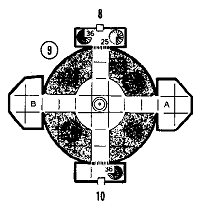
This area may be entered through doorways
from areas 8 and 10, by one stairway
down from area 25, or by two stairways
coming up from area 36. The entrances to
this area are screened by illusionary walls,
which may be detected as secret doors or
traps. Beyond the illusions is a large domed
room; intense violet and ultraviolet light
shines from the ceiling over a garden of
fungi, mushrooms, and other bizarre plant
life. Few of the plants are ambulatory, many
are poisonous if eaten, and a few (by DM's
whim) may have special properties.
The garden is quartered by four paths
that meet at a small circular plaza, in the
center of which is a fountain. Anyone who
drinks from the fountain will experience
some strange effects with each drink; the
DM can invent a random-roll table of peculiar
effects, most of them harmful.
The level of ultraviolet light in the room
will cause characters to suffer visual problems
if they stay there for long; for every
five rounds spent in this room at one time,
a character will gain a cumulative penalty of
-1 on his ?to hit? roll, which will last for a
cumulative duration of one turn ? beginning
as soon as the character leaves the
room (because it will take a while for one?s
eyes to readjust to normal light). Thus, a
character who spends ten minutes searching
the room will have a -2 penalty ?to hit? for
20 minutes after leaving the room. The
ultraviolet light cannot be dispelled.
Rooms A and B are filled with gardening
tools, biological experimentation equipment,
tables, and botany notes. Room B
has a large culture of green slime in a stone
jar, with a permanent illusion cast upon it to
make it appear to be a pile of gemstones.
10) Grand Museum -- CH, rooms A-H
have 10 flat ceilings, and room I has a 30
ceiling; IL, each room A-H has 1 CL in
ceiling, while room I has 4 CLs in ceiling.
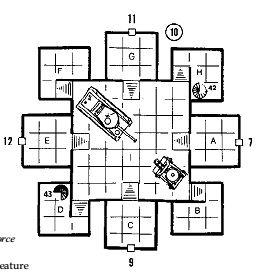
Numerous relics, few of them magical in
nature, occupy the various rooms of the
Grand Museum. All of the items here are
trophies of Baba Yaga?s wanderings, some
taken in battle and some by stealth and
magic. The hides of demons, devils, and
dragons hang beside broken weapons taken
from champions who opposed her in ages
past. The largest items are two huge metallic
vehicles in room I; one of them is a
Soviet JS-1 tank she picked up while visiting
Earth during the Second World War,
and the other is a steam-powered war cannon
made by dwarves from an alternate
universe. Neither device is operable (even
with a wish), and should serve only to confuse
the characters. The tank and dwarven
cannon weigh 43 and 25 tons respectively.
Additional items may be invented by the
DM as desired; few trophies in the museum
should be immediately recognizable for
what they are, since Baba Yaga has a taste
for the strange and unusual. A few trinkets
may still possess their powers.
Inter-area doorways connect to areas 7,
9, 11, and 12
from here. Staircases rise to
area , and descend to area 43.
11) The Lakeland -- CH, hemispherical
dome 275 high; IL, dim, equals twilight or
overcast day (see below; ND).
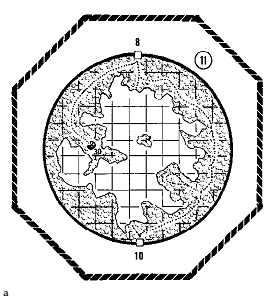
Characters entering this enormous area
from 8, 10, or 30
may at first believe they
are outdoors. The Lakeland area is an
enormous circular domed room 550? in
diameter, with a shallow lake in the center
of it surrounded by dense forestation. The
lake itself is swampy and no more than 15?
deep at the most, with algae and leafy
plants covering much of its surface. Narrow
footpaths wind their way around the lake
shore from doorway to doorway, and over to
a circular staircase hidden among the trees,
leading down to area 30. The trees reach
20?-80? in height. The diffused light shines
from the dome itself.
The lake is the home of three greenhags
(HP 46, 52, and 61) who are close friends of
Baba Yaga; the witch often turns captives
loose in this chamber for the greenhags to
feed upon. A fair amount of treasure (determined
by the DM) has been accumulated
here by the greenhags, kept well guarded on
the lake bottom near their lair.
12) The Vaults -- CH, 20 flat overall; IL,
rooms A, B, and center chamber have 1 CL
each in ceiling, all other rooms are dark.
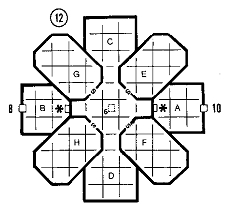
Characters entering from area 8 or 10
will see only a bare room (A or B) with a
door on the opposite wall. Walking through
the door at the other end of the chamber
(marked ?*?) normally teleports characters
directly across to the opposite room (from A
to B, or B to A), unless the character casts a
dispel magic successfully at
the door against
25th level magic, or uses an anti-magic shell
spell or scroll of protection from magic field
that crosses the doorway. If this occurs, the
teleport effect is dispelled for 7-12 turns,
and the characters may walk directly into
the center chamber. A secret door, detectable
by normal means, is set in the ceiling
of this chamber.
Rooms C and D are storage areas for
unusual minor treasures that Baba Yaga has
picked up; some are worthless except as
souvenirs, while others are rather valuable
(items of jewelry and the like). From 2-5
magic items may be found in each of these
two rooms; some of the items may be cursed
or trapped in unusual ways.
The four major treasure vaults are rooms
E, F, G, and H. The entrances to these
rooms are not detectable without magical
means (a gem of seeing,
a true sight or true
seeing spell, and so forth). Each secret
entrance also bears a special curse, as determined
by the DM. Any character attempting
to open one of the doors could be
polymorphed into a giant rat, paralyzed and
rendered invisible, made gaseous for 2-8
hours (without equipment, and unable to
cast spells of any sort), or cursed to see their
allies and friends as deadly enemies. Baba
Yaga will not be affected by these curses.
Anyone who gets past a door will find
that each of the vaults has a guardian inside.
Room E is home to a greater basilisk
(65 HP), F has four slicer beetles (33, 35,
40, and 47 HP), G has a dracolisk (45 HP),
and two flesh golems guard room H. The
exact treasure in each room is left to the
DM, though it should be emphasized that
despite the size of the vaults, they will not
be stuffed with magical items or gold.
Room E, for instance, might have three
major magical devices, a small chest full of
antique platinum coins, a rare magical
tome, and several items of jewelry and rare
tapestries set in cases on the walls.
None of the guardians will attack Baba
Yaga because of her enchantments upon
them, but they will attack anyone else who
enters the chamber they occupy.
13) Abyss Hall -- CH, 60 flat ceiling over
walkway; IL, none.
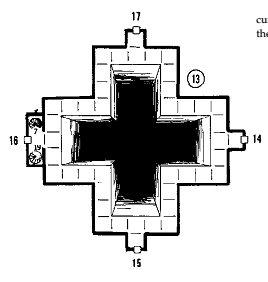
This central hall has a cross-shaped 10?
wide walkway running along what appears
to be the edge of a great abyss. Anything
that falls off the walkway will drop for a full
round at ever-increasing speed, and will
then suddenly be cast out of the Hut
through a one-way magical gate into a
random section of the Astral Plane. Because
the gate effect lasts for only a moment, this
section of the Hut is not considered open to
other planes, and spells that won?t function
because they require contact with other
planes will also not function here. No
guardians usually patrol this area. Note the
potential use in this area, for or against the
party, of spells like push and telekinesis.
Doors lead out from this area to areas 14,
15, 16, and 17,
and staircases connect with
areas 19 (above) and 7 (below).
14) Baba Yaga?s Chambers -- CH, 10 flat
in room A, 40 peaked ceiling in room B,
20 flat in rooms C-F; IL, see below.
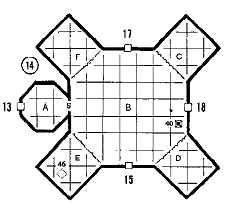
Anyone passing through the doorway
from area 13 to area 14 will find
himself in
a stony, octagonal room which contains
nothing at all. Only magical devices like a
gem of seeing or spells like true sight or true
seeing have a chance to detect the secret
door on the opposite wall. Even if it is detected,
the secret door will only open if a
passwall spell or a wish is used on it. It
automatically opens at Baba Yaga?s touch.
One guardian resides in room B: a farastu
demodand (64 HP) that has made itself
invisible and will attack anyone but Baba
Yaga, her servants, or her ?daughters.?
Baba Yaga?s personal chambers are dimly
lit by small candles set upon tables, chairs,
wall mountings, and elsewhere. Room B is
rather spacious, and contains only a few
articles of furniture (a workbench, several
chairs, a writing table with chair, and several
small bookshelves). Nothing appears to
be of any value here, at first glance. Doors
lead to areas 15, 17, and 18. A secret door
in the floor, covered by a rug but detectable
by normal means, leads to area 40. A rug of
welcome that appears shabby and faded
rests on the floor by the door to area 18.
The side chambers are screened by thick
curtains; if anyone but Baba Yaga touches
them, the curtains will animate and fold out
over the toucher like a lurker above (use all
statistics for the lurker above, except that
the curtains do not normally move about,
and each has 55 HP). Room C is Baba
Yaga?s sleeping chamber, D and E have
equipment that she uses when manufacturing
magical items, and F contains a loom
and assorted items for sewing and making
woven items. Few magical devices will be
found, most of them relatively minor in
nature (a wand of magic missiles, for instance).
Room E has a secret door in the
ceiling which can only be detected and
opened in the same manner as the ceiling
trap door in area 4 (leading to area 40). The
ceiling door here leads to area 46.
15) Natasha?s Chambers -- CH, rooms A,
C, E, G, and I have 10 flat ceilings, and
all other rooms have 10 tall walls with
square-domed ceilings up to 15 high; IL,
all rooms (A-I) have 1 CL in ceiling each.
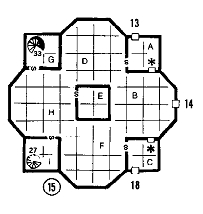
Anyone entering from area 13 or 18 will
find himself in a small room (A or C) that
connects with its counterpart through a
teleportation door. This allows pedestrian
traffic to avoid Natasha?s rooms, a feature
that was devised because of her extreme
dislike of interruptions during her relaxation
time. Secret doors in rooms A and C
are normally detectable, and lead directly
into the main area. Rooms G and I hold
stairwells to areas 33 and 27 respectively,
and a doorway connects directly to Baba
Yaga?s chambers (area 14).
Natasha the Dark is an adopted human
?daughter? of Baba Yaga who was influenced
by the witch to take up her sorcery
and use it for dark purposes. A beautiful
woman with smoky black hair and alabaster
skin, Natasha enjoys manipulating demons,
and uses them frequently as servants and
guardians. She is jealous of her ?sister?
Elena (see area 17), and despises her goodness,
but will never cause Elena harm.
Natasha is a chaotic evil dual-classed
illusionist/magic-user, 7th/15th level (HP
43, S:9, I:18, W:12, D:17, C:15, CH:16)
who wears a variety of magical protective
devices (such as bracers of AC 2, a brooch
of shielding, and two random ioun stones).
She carries many offensive spells in her
head. Materialistic and vain, she collects
magical items and jewelry. and displays
them for all to see. She may be further
outfitted by the DM as desired.
Being as paranoid as her ?mother,?
Natasha has few valuable items lying
around in her area. Rooms B, D, F, and H
contain only mundane but costly furniture.
Most of her valued items are contained, and
her private research is conducted, in area
33, the stairway to which is within room G.
The secret doors in rooms G and I are
detectable by normal means. Inside room G
are a pair of invisible stalkers who guard the
entrance to Natasha?s laboratory; they will
attack anyone but Natasha and Baba Yaga.
16) Hades Guestrooms -- CH, 10? flat
overall; IL, see below.
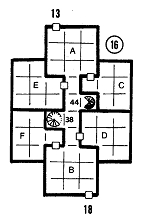
These chambers are primarily used by
night hags who are visiting Baba Yaga from
Hades (having gated in through other
areas
inside the Hut). Rooms C, D, E, and F
have dim light emitting from their ceilings
(ND); special enchantments will negate any
light or continual light spells cast within
them. Night hags cannot astrally project
themselves from these rooms. Each room CF
has a 20% chance of a night hag occupying
it; unoccupied rooms have a 20%
chance of containing an annis maid who is
fixing up the chamber for new guests.
Doorways lead to area 13 and 18,
and
stairs lead down to area 44 and up to 38.
Though completely dark, entry rooms A
and B are kept free of obstructions and
furniture. The walls there are decorated
with paintings showing various grotesque
scenes from the local landscapes in Hades.
17) Elena?s Chambers -- CH, 8? flat
overall; IL, all rooms have 1 CL in ceiling
each, except room E (no light).
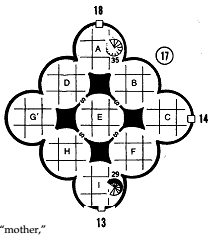
Another foster ?daughter? of Baba Yaga
is Elena the Fair, who, unlike her ?sister,?
turned out to be lawful good in nature. She
has learned magical arts from her ?mother?
but uses her powers for good causes. Baba
Yaga found Elena outside her Hut one day
and, being unwilling and perhaps unable to
slay her (for reasons given in the witch?s
character description), kept her as a house
servant. No one came to claim the girl, and
soon she became a powerful sorceress.
Though she is disliked by all other beings
who come to the Hut, no one dares harm
her, and all treat her with the greatest respect
(if somewhat begrudgingly).
Elena is a 16th-level magic-user
(HP 39,
S:11, I:18, W:17, D:16, C:10, CH:17) who
carries no magical items with her. Her
repeated exposure to illusionary displays
has finally rendered her immune to-all.
illusion/phantasm spells, regardless of level,
and she cannot be affected by them. If she
encounters any characters of good nature,
she will become very friendly with them,
but will not allow any harm to come to
inhabitants of the Hut if she can help it.
Elena likes to use polymorph other and
polymorph self spells, and will not use any
illusion/phantasm spells.
Elena?s rooms contain mundane (though
highly valuable) articles of furniture, as well
as-trinkets from a dozen universes that she
has collected. A few of these items have
magical powers of an unusual nature (possibly
a lamp with the powers of a wand of
illumination, or a wastecan that disintegrates
all materials dropped into it); the
DM may use his imagination to the fullest.
At most, five such items will be found.
Elena?s chambers are warded by non-lethal
magical traps of various types (symbols of
sleep or stunning, or an activated Bigby?s
grasping hand that holds thieves for 16
minutes).
Room E can be entered only through
secret doors, all normally detectable (though
protected as noted above). Inside Room E
are Elena?s bedchambers, which are dark.
18) Bath -- CH, rooms A-D have 10?
flat ceilings, central pool room has 25?
ceiling; IL, rooms A-C have dim red light
coming from whole ceiling, D has bright
white light from ceiling, pool room has
variable light (see below; ND).
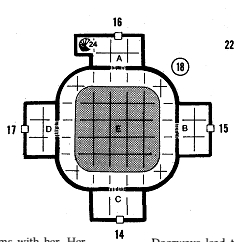
The four small chambers surrounding the
large central pool each contain dressing
facilities and other odds and ends for bathing.
Because some of the visitors in area 16
are night hags, the pool isn?t always filled
with pure water, and bathing equipment
varies. The pool is only five feet deep
throughout. Illusionary walls screen the
pool from rooms A-D. The pool room, E, is
dimly lit, equivalent to late twilight, but the
brightness can be increased to full daylight
with a command word (?Light!?). Other
command words will cause the pool?s waters
to become either pure or foul, depending
upon the preference of the bather (only
Elena and Natasha have a liking for pure
bathing water).
Doorways lead to areas 14, 15, 16,
and
17, and a stairway in room A descends into
area 24 (so beings may wash up after visiting
the stables).
19) ?Cellar? -- CH, 10? flat overall; IL,
torch on wall near door to B.
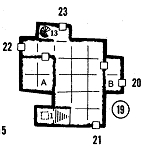
The walls of the ?cellar? are made from
packed earth, but very little can be flaked
off or dug away; like all other walls in the
Hut, these are immune to spells like dig or
disintegrate.
The musty ?cellar? serves as a dumping
ground for items newly brought in from one
of Baba Yaga?s trips around the land, as
well as a sort of trash bin for unwanted
nonmagical refuse. Few things found here
will have any real worth, though some may
prove interesting as curios.
A single torch burns on the wall near the
interior door leading to room B. Room A is
filled with skulls and bones of adventurers
who fell victim to the Hut or its guardians
? perhaps seventy creatures of various
races are represented. Room B is empty,
but has a large executioner's
hood (6+6 HD,
49 HP) that hides in a niche in the ceiling,
covered by an illusion to further conceal it.
It will attack anyone who enters room B
other than Baba Yaga or other full-time
inhabitants of the Hut, going for the intruder
?s head.
20) Wine Cellars -- CH, 10? flat in rooms
A-D; IL, none.
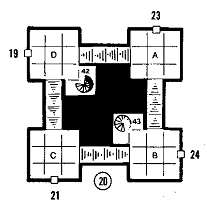
Rooms A, B, C, and D each hold numerous
kegs, barrels, and bottle-filled shelves
containing the finest alcoholic beverages
that twelve universes have to offer. Room A
contains fine wines, B holds brands of
vodka, C has assorted beers, meads, and
ales, and room D is filled with exotic fruit
drinks. Some of the drinks (20%) will infect
the imbiber with dipsomania,
as per the
DMG, due to their quality and certain
special enchantments.
Characters will soon discover that one
can go continuously downstairs from room
to room in this area, thanks to a peculiar
warping of space that cannot be negated by
magical or physical means. Hiding behind
one of the wine barrels is Ivan, a giant
mouse who can communicate telepathically
with beings up to 10? away from him (like
the ability of Vladimir the giant cat, from
area 1). Ivan is one foot long (AC 6, MV
12?, HD 1+1, HP 9, bites for 1-4 HP) and
is very intelligent; he can learn and cast
spells like a 4th-level magic-user. Ivan has
chaotic good alignment, and a bad case of
dipsomania; he will befriend anyone who
offers him alcoholic drink, and (like Vladimir)
he may be willing to offer limited
information about the Hut.
21) The Warded Caverns -- CH, 10?
overall; IL, none.
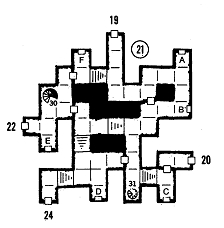
The Warded Caverns have numerous
magical spells cast within, to confuse all
who pass through, except for Baba Yaga
and her ?daughters? and servants. If one of
them enters this area, all magical effects in
the caverns will cease for the time the inhabitant
is in the corridors, and will reactivate
as soon as the inhabitant leaves.
To begin with, a guards and
wards spell
of permanent duration (except as noted
above) fills the entire cavern area. Visibility
is reduced to 10? at best, all interior doors
are wizard locked (25th level) and covered
with illusions to appear like wall sections.
Webs fill the stairways, but not the spiral
staircases. Stinking clouds fill areas G and
H.
In addition, six teleportation doorways
have been added that exactly resemble the
inter-area doorways. These doors, labelled
A-F, will randomly teleport anyone who
passes through one of them to a different
teleporting doorway. (The character will
reappear inside area 21, facing the doorway
to which he has been teleported.) The doorway
teleported to is determined by rolling a
6-sided die (1=A, 2=B, etc.); if the same
doorway is rolled that the character just
entered, then the result is re-rolled. This
process is repeated each time a character
enters a doorway.
Four normal inter-area doorways connect
to areas 19, 20, 22,
and 23. Circular stairways
join with areas 30 (above) and 31
(below).
22) Smithy and Toolworks -- CH, 30? flat
(20? over D, 10? over E); IL, only from
fires and furnaces, as noted below.
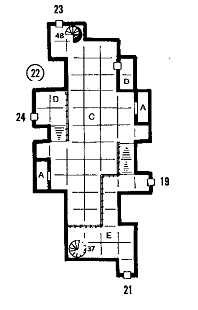
The walls, ceiling, and floor of this room
are constructed of a special metal that does
not conduct heat; no heat radiates away
from the smithy, and it can become extremely
hot when heavy work is going on.
Baba Yaga has enslaved some beings from
the Elemental Plane of Fire, and
here forces
them to forge magical weapons and devices
for her. Three azer, a salamander,
and a
harginn grue labor for hours on
end at the
furnaces. Currently they are forging a twohanded
sword that Baba Yaga hopes to turn
into a cursed berserking sword, which she
will then give to some enemy of hers.
Two furnaces provide dull red light in this
area, from the places marked A on the map.
A toolroom is present at B. The main floor
of this area is C, though there are two elevated
places; D is 10? above the main floor,
and E is 20? above the level of C. Both of
the elevated sections are set off by railings.
The heat in this entire area is so intense that
unless someone has some form of protection
from heat and fire, he will take 1 HP dam-
age per round that he is in the area. The
inhabitants of the room will ignore anyone
who enters here, unless he crosses the main
floor (C) and is seen to be an ?outsider?
i.e., not Baba Yaga, her ?daughters,? or
servants). The workers will then attempt to
capture or slay the intruder(s), preferring to
hold them for Baba Yaga (if possible) in an
attempt to win her favor.
Inter-area doorways lead to areas 19, 21,
23, and 24; circular stairwells rise to area 37
and drop to 48. Note that the heat from this
room, like magical or magic-like effects,
does not enter other areas through the open
circular stairs.
23) Armor Museum -- CH, 15? flat overall;
IL, rooms A-D have 1 CL each, and
room E has 4 CL?s on ceiling.
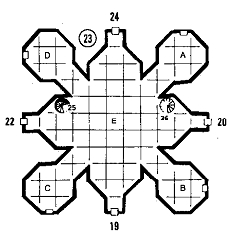
The armor, shields, and helmets of great
champions who once served Baba Yaga, or
who opposed her, are kept in these chambers
as mementos. The central chamber, E,
contains equipment from dozens of alternate
universes, of many makes and compositions.
Some of the suits are magical, and a
few are legendary in nature (once having
been worn by famed warriors). Details of
these exhibits are left to the individual
referee to develop.
Rooms A, B, C, and D contain equipment
from four universes of particular
interest to Baba Yaga, since she has relatives
who live in them. One room is devoted to
armor worn by men destroyed by three of
Baba Yaga?s sons, who are aquatic hydras.
No further information on them can be
found here.
The staircases lead up to area 36 and
down to 25; four doorways connect to areas
19, 20, 22, and
24.
There are four teleportation
doors in the side chambers that operate
like the ones in area 21, except that each
doorway sends a character to another specific
doorway: A leads to B, B to C, C to D,
and D to A. Only one character can enter
any doorway at one time.
24) Stables -- CH, 10? flat, with 15?
square-domed ceiling over section I; IL, 1
CL over section I.
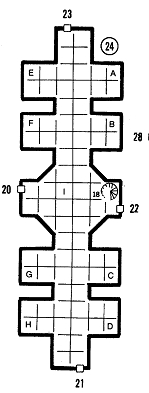
This is one of the few areas in the Hut
with connections to the Astral and Ethereal
Planes. Also, the Prime Material Plane,
Negative Material and Elemental Planes,
and one Outer Plane (Hades) may be
reached from here by spells. Because it has
these special properties, this area is kept
heavily guarded. All spells and powers
which have a spell effect listed above of(P)
will function here normally.
Stabled here are three nightmares at A,
C, and F (39, 43, and 46 HP respectively),
watched over by four diakka, two
tall ones
(41 and 49 HP) and two broad ones (55 and
61 HP). The diakka are overseen by a
barbed devil (63 HP). The devil and the
diakka dislike each other, but will cooperate
to remove intruders from this area.
The nightmares will attack any humans
and demihumans who enter the stables
(they are not restrained). The devil and
diakka will stay out of the way until after
the tight, unless they feel they can join in
without serious risk to themselves.
In stall G is a large iron mortar and
pestle, 4? tall, with a broom inside the
container as well. The mortar may be summoned
by Baba Yaga when she is outside
her Hut, by simply whistling for it to appear;
the mortar, pestle, and broom are
enchanted to serve as an overland vehicle
for her. The mortar levitates one inch above
the ground upon utterance of a command
word, and can carry up to 500 lbs. inside it.
Baba Yaga sits inside the mortar and poles it
along the ground using the iron pestle. The
maximum speed one can attain using this
device equals twice the ?driver?s? strength
score in tens of yards per minute; thus,
Baba Yaga can move at 40? per round, or
about 13.6 mph. Percentile scores for
strengths higher than 18 are ignored for
purposes of this calculation. It takes one
round for the mortar to reach full speed.
The broom is enchanted to cover all
traces of the mortar?s passing over the
ground, as per the druid spell pass without
trace with a permanent duration. Baba
Yaga can manipulate both the mortar and
the broom simultaneously.
25) Divination Chamber -- CH, 10? flat
in chambers A-D, and 40? hemispherical
dome over E; IL, 1 CL over room E, all
else dark.
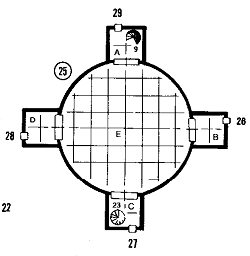
The Divination Chamber is used by the
Hut?s inhabitants to cast divination-type
spells such as contact other plane and legend
lore, as well as serving as an alternate
summoning room for conjuring creatures
from the Outer Planes for advice. This
chamber is open to the Astral, Ethereal,
Prime Material, and other planes, and all
spells listed above with the note ?(P)? will
perform normally here.
Room E is the actual summoning and
divination room; rooms A-D are preparation
and entry rooms. Because this whole
area is open to transplanar powers, two
mezzodaemons (103 and 115 HP)
patrol
these rooms to protect them from invaders
or spies. Anyone entering here who is not
recognized as an inhabitant of the Hut will
be attacked at once, though the daemons
will not leave this area to pursue invaders.
The stronger of the two mezzodaemons
keeps a vigil in room E, while the other
guard roams between rooms A-D, visiting
each small area once every four turns.
Areas 26, 27, 28,
and 29 connect to this
area by doorways, and areas 23 and 9
connect
to this area by staircases going up and
down, respectively. The giant double doors
leading into rooms A-D are so massive that
a bend bars/lift gates roll is required to open
them. A character who knocks on one of
these doors from within the small room will
quickly attract the attention of at least one
of the guards.
26) Alchemical Storage -- CH, 10? flat
overall; IL, rooms A-D each have 2 CL?s,
one in each corner, and room E has 4 CL?s,
one at the top or foot of each stairway.
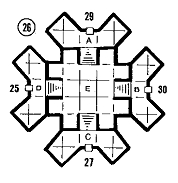
The walls in this area are lined with
shelves and boxes full of alchemical materials
used in the preparation of magical potions,
poisons, inks, medicines, and
chemical substances. Many of the materials
have deteriorated from age and disuse, and
some will now produce altered effects if
used in magical rituals or experiments. The
contents of these rooms came from numerous
worlds, and most of them are labelled as
to their origin. Room A contains various
acids and caustic liquids; B has an assortment
of solid components; C has biological
supplies; and room D contains gems and
unusual materials (demon ichors, devil
scales, and so forth).
If a magic-user or illusionist looks long
enough here, he will probably find any
chemical components for his spells or alchemical
preparations that he desires. However,
as noted above, there is a chance
(15%) that whatever materials are found
will be useless or will produce unexpected
effects if used.
Only two guardians patrol this area.
Baba Yaga has rendered two grells invisible
using a permanent form of improved invisibility
so they may attack without being
seen. Normally the grells (33 and
41 HP)
hover near the ceiling over room E, and will
silently descend upon anyone who isn?t a
permanent resident of the Hut. The grells
will pursue prey anywhere they can, even
through other areas.
The doors in this area lead to areas 25,
27, 29, and 30.
27) Magic Item Storage -- CH, 10? flat
overall; IL, en tire ceiling radiates light as a
CL spell (ND).
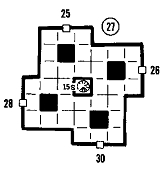
Material components not of a chemical
nature (metallic items, miniature figures,
and so forth) may be found on the marble
shelves lining the walls of this large room.
Materials to be used in manufacturing
magical items, such as staves, wand sticks,
platinum rings, and scroll papers, may also
be found here. However, few completed
items are in this area; they are either in use
by the Hut?s inhabitants or stored elsewhere.
Anyone who looks over this area?s contents
will notice that the metallic items have
been placed in sealed stony crates or glass
jars, or have been set high on the shelves;
wooden items are also protected or hidden.
The reason for this is that the room?s guardians
are three rust monsters (29,
34, and 39
HP). They feed freely on iron items that
Baba Yaga and the others toss to them, and
have been trained not to approach Baba
Yaga or her ?daughters.? They will happily
go after anyone else they can, however. To
make them more difficult to slay, each rust
monster has been outfitted with a collar
enchanted to cause any wooden item touching
the monster to warp, as per the spell
warp wood. Magic wooden items get no
saving throw vs. this effect.
A secret door is set in the room?s central
10? x 10? pillar, leading to a spiral stair that
descends to area 15. Doors lead off to areas
25, 26, 28, and
30.
Anyone who attempts to
open the secret door besides Baba Yaga or
her ?daughters? must save vs. spells at -4
or be permanently feebleminded. This trap
will only function once.
28) Room of Conjuring -- CH, 10? flat in
rooms A and C, 15? flat in room B; IL, 1
CL on ceiling of room A, dark elsewhere.
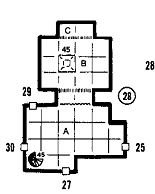
This area is open to other planes, and
spells that normally won?t function because
of the Hut?s extra-planar construction
(those marked (P) in the lists) will all work
here. Room A contains a few tables and
chairs, with exits to areas 25, 27,
29,
and
30, as well as stairs down to area 45.
Curtains
separate this room from B, the actual
conjuring room.
One-way illusionary walls allow viewers
in rooms A and C to look into B without
being seen; from B, these illusions appear to
be normal walls. A protective diagram is
drawn in B, beside a special trap door 10?
across upon which a conjuring pentagram is
inscribed (as per the spell cacodemon).
Anyone who conjures a being into this room
will have it appear within the pentagram,
and may then use spells similar to
spiritwrack or cacodemon to get concessions
or quests from it. It is possible to cause the
trap door to lower into area 45 at a word of
command, and cause the summoned being
to be trapped within the ?prison? there.
The trap door will teleport back to its
former position as soon as it touches the
floor, leaving the unbound being in the wall
of force cage in area 45.
Room A is a sort of guard room; an old
shator demodand spends his time here as a
guardian of this area, preventing intruders
from getting any further into the complex.
The shator has 104 HP,
and obeys no one
but Baba Yaga herself.
29) Grand Library -- CH, 15? flat in each
room; IL, each room has 5 CL?s, one in
center and one in each corner.
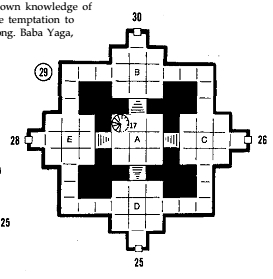
The library is divided into five chambers
(A-E), each having numerous volumes and
tomes filling the shelves that run along their
walls. The spell books of ancient mages lie
here beside texts discussing the nature of
magic and the universe, and volumes covering
hundreds of other topics. Exits to areas
25, 26, 28, and
30
are here, and a staircase
in room A rises to area 17. DMs may determine
the contents of rooms A-E as desired.
Numerous creatures and beings use these
chambers to further their own knowledge of
the sorcerous arts, and the temptation to
steal a book or two is strong. Baba Yaga,
however, has caused three rakshasas to
serve as guards here. The rakshasas
(39, 42,
and 50 HP) use their illusionary powers to
appear to be studious mages, of a temperament
friendly to whoever else is using the
library. If they catch anyone stealing or
damaging books (using their ESP powers to
help in this detection), then they will attack
at once to capture or slay the offender.
Note that though rooms C and E seem to
be on a different level from B and D, anyone
walking in a circle through these rooms
using the outer corridors will believe he is
on the same level all the time. This area,
like area 20, was built around a section of
warped space.
30) Alchemical Laboratory -- CH, 10?
flat overall; IL, 1 CL centered on ceiling.
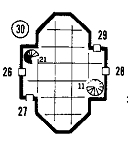
The alchemical laboratory is outfitted
with most of the standard equipment that
one would expect to find here (lab tables,
shelves full of glassware, retorts, etc.).
Explorers will find 3-12 potions here; some
of them poisonous or cursed, but all completely
indistinguishable from one another.
Rare powders, liquids, and devices may
also be found here, though unless one
knows what to look for, most of this material
will be ignored.
Only one creature normally inhabits this
room, a kobold (4 HP) that Baba
Yaga has
permanently charmed and made her servant.
The kobold has only one type of offensive
weapon: three small tubes full of
magical dusts. One contains dust of stunning,
which has the same effect as a symbol
of stunning upon those affected; dust-of
sneezing and choking; and dust of hopelessness
(as per the symbol).
The kobold wears a ring of invisibility,
and has been given the power to detect
invisibility naturally, by Baba Yaga?s magic.
He will use the dusts on anyone who enters
the lab invisibly. When it blows through a
tube, the kobold causes the dust in that tube
to scatter through the room, affecting everyone
inside except himself (Baba Yaga?s
magics having rendered him immune to
their effects). The kobold will then summon
help from one of the rakshasas in area 29 to
capture or dispatch the intruders. Only
Baba Yaga and her ?daughters? may use
this area, though other inhabitants of the
Hut may pass through it to get elsewhere.
Doorways here connect to areas 26, 27,
28, and 29, and stairways climb
to area 11
and drop to area 21.
31) Prison -- CH, 10? flat, except in cells
(6? flat); IL, none in room A, 1 CL in
rooms B and D each.
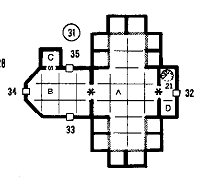
This area is reserved for those captured
trying to steal from or invade the Hut, as
well as for regular enemies of Baba Yaga.
Room A includes 12 prison cells, each shut
with a wall of force. The walls may only be
dispelled using disintegrate, or by command
of Baba Yaga herself; each cell must be
opened or closed separately from all others.
To guard the prisoners, a Type
V demon
(55 HP) has been forced to serve in this
room. The demon hates its servitude, and
this has given it an especially foul disposition
(+1 ?to hit? and damage on all attacks).
Anyone entering this area except for Baba
Yaga and her daughters will be attacked at
once; the demon carries six broadswords.
Rooms B and D are generally empty
except for pedestrian traffic. If anyone
crosses the open doorways from B or D into
room A, without first casting a dispel magic
at the doorways, a special teleporter goes
into effect and casts the person into one of
the unoccupied cells in the prison. All nonliving
equipment the person is wearing or
carrying is teleported at the same time into
room C. If all the cells in room A are full,
then prisoners will be dropped into occupied
cells, doubling up until they have to be
tripled up, and so forth. There is no saving
throw against this teleport effect. Only 1-2
prisoners will be present in the cells to begin
with, their characteristics, levels, and reasons
for imprisonment being left to the
DM?s imagination
Room C has no guards inside, but the
door to it is detectable only by using a gem
of seeing or a true sight or true seeing spell.
A passwall or phase door spell will open it.
Room B contains exits to areas 33, 34,
and
35; D has an exit to 32 and stairs
up to 21.
32) Food Storage Lockers -- CH, 10?
overall; IL, rooms A-D dark, 1 CL centered
in corridor on ceiling.
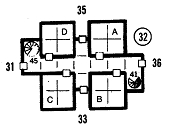
The food lockers are unguarded, and a
number of residents of the Hut (as well as
some visitors) will come here to snack.
Rooms A-D are kept at low temperatures by
magical effects, and different sorts
of meats are hung out in them. Rooms
A and B contain meat from normal
animals, C contains meat from monsters,
and D has meat taken from other sentient
beings (elves, gnomes, dwarves, etc.).
Areas 31, 33, 35,
and 36 may be reached
by inter-area doorways. Spiral stairs reach
up into area 45 and down into area 41.
33) Natasha?s Laboratory -- CH, 10? flat
in room A, 15? flat in room B; IL, 1 CL in
rooms A and B each.
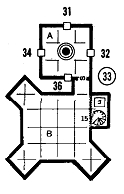
Anyone entering here from area 31, 32,
34, or 36 will at first see only a 30? square
room with a circular well 10? in diameter
set in the center of the room. The well is
filled with green watery fluid to the brim,
and seems to have no bottom. If someone
casts a lower water spell upon the water, it
will not be affected; however, a secret door
will open in the room, leading to the laboratory
of Natasha the Dark. The secet door
cannot be opened by any other means,
though it may be detected normally.
Natasha?s laboratory (room B) is fairly
standard, and contains much the same
equipment and treasures (2-8 potions, some
cursed) as the alchemical laboratory in area
30. Two manes (8 HP each) and two
lemures
(18 HP each) serve as assistants here,
moving into one of the side chambers when
not needed. If anyone but Natasha or Baba
Yaga enters this area, the manes and lemures
will attack at once.
An illusionary wall on one side of the
room covers a prismatic wall that has been
made permanent by various spells. Only
Baba Yaga and Natasha are able to pass
through the wall without ill effects. The wall
cannot be detected from inside the small
chamber, either, since an illusionary wall
covers it from that side as well. The wall
hides a stairwell going up to area 15, and a
trap door leading down to area 5.
34) Guardians and Servants -- CH, 10?
flat overall; IL, see below (ND).
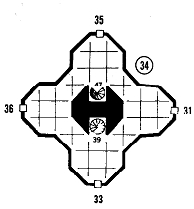
This area is filled with a luminous, humid
fog kept at a warm temperature; the visibility
is only 10?. Living within this area are
nine piscodaemons who serve Baba Yaga,
though unwillingly, when she requires minor
errands or tasks to be performed. The
piscodaemons (29, 31, 34,
34, 37, 38, 39,
43, and 46 HP) will not leave this area
unless commanded to do so by Baba Yaga
or her ?daughters,? and will fight anyone
else who tries to enter (even the other servants).
Inter-area doorways lead from these
rooms to areas 31, 33, 35, and 36; stairwells
drop to area 47 and rise to 39. The fog will
not leave this area and enter any other area.
These piscodaemons are permitted to have
some treasures (DM?s choice), which they
guard cautiously.
35) Fountain of Life -- CH, 10? over the
small exit rooms and stairwell down, with a
35? hemispherical domed ceiling over fountain
chamber; IL, see below.
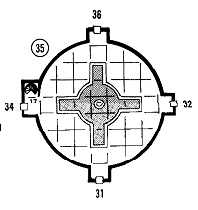
No illumination is needed in this chamber,
since the waters themselves give off
light. A huge cross-shaped fountain is centered
in this area, with doorways leading off
to areas 31, 32, 34,
and 36 around it. A
spiral staircase drops to area 17.
If anyone drinks from the fountain, a
number of beneficial effects may be gained.
One drink will have the same effects as one
application of Keoghtom's ointment (curing
9-12 HP of damage and either curing a
disease or removing poison from the
drinker). The magical effects of the water,
however, will not last more than one round
if it is taken out of the pool. No magical
power can cause the water to keep its effects
if it is stored in any container. No magical
spell will destroy the fountain or the powers
of the water within it.
This area is not guarded. Anyone, even
Baba Yaga herself, may drink from the
waters and be healed.
36) Servants? Chambers -- CH, 10? flat
overall; IL, 4 CL?s, one over each exit.
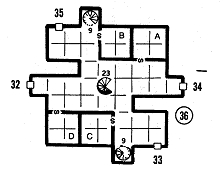
This area is the servants? quarters for
Baba Yaga?s annis maidservants. Rooms AD
each have beds and furniture to indicate
that two annis live there; there is a 20%
chance that one annis (of random HP) will
be encountered in each room, resting from
her chores. All annis will fight any intruders
in their area to the death. Each room has
some treasures that the maids are allowed to
keep, though no treasures are of extraordinary
power.
Exits lead off to areas 32, 33,
34,
and 35
from the hallways. Two staircases rise to
area 9, and one descends to area 23.
37) Food Storage -- CH, domed ceiling,
25? at center; IL, four torches, one on the
wall between each pair of food bins.
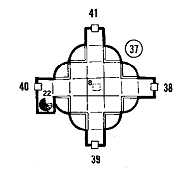
All foods besides meats and beverages are
stored here in eight special containers set
against the walls. The food bins will cause
perishable foodstuffs placed inside them to
be preserved and replenished indefinitely, so
that vegetables, grains, breads, pies, eggs,
fruits, and vegetable oils may be taken from
the bins without needing to refill them.
There are no guards here, but there is a
30% chance of an encounter here, since
snacking is a common pastime among the
Hut?s inhabitants.
Exits lead out from this area to areas 38,
39, 40, and 41;
a stairway takes characters
down to area 22. In the center of the ceiling
is a clearly marked square ? the platform
from area 8 lowers down into this area. A
word of command (?Down!?) will cause the
platform to descend into the chamber.
38) Meeting Hall -- CH, 15? flat overall;
IL, 1 CL over central stairwell.
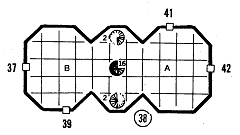
This huge auditorium is used only rarely,
when Baba Yaga desires to call together a
large group of night hags for special meetings.
Usually it is kept empty (the chairs
and tables needed are created on the spot
using various magical spells). The walls are
engraved with detailed pictures showing the
history of Baba Yaga and her Hut, the
many battles they?ve fought (and won), and
the champions they?ve fought against.
There is a 10% chance of encountering a
lone diakka (45 HP) sweeping the
floor or
polishing the walls here.
39) ?Outdoor? Garden Maze ? 10? flat
overall; IL, ceiling illuminates room (see
below; ND).
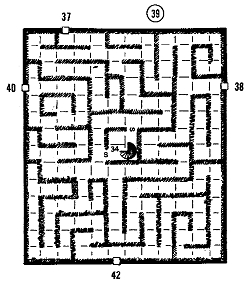
This unusual area appears to be an outdoor
hedge maze; a false ?sun? appears to
shine overhead, though it is only an illusion
and the ceiling is as high as the hedge-tops.
This maze connects with rooms 37, 38,
40,
and 42. In the center of the maze is a stairway
leading down to area 34. One foot of
earth covers the floor, but it cannot be
affected by spells or dug completely away.
The hedges appear to be a strange combination
of thornbushes and fruit-bearing
plants; large red berries the size of apples
grow upon it in a few places. Each character
has a 10% chance per one round?s worth of
normal movement (see below) through the
maze to see 1-2 of the berries. The berries
can be taken from their branches, but will
lose their special properties within one day
after they are removed from the area of the
maze. If a berry is eaten, there is a 90%
chance that it will act to dispel exhaustion
(at the 6th level of power) on the consumer;
the other 10% of the time, the eater will be
deluded (as per a potion of delusion) into
thinking that his wounds are cured when
they haven?t been.
If anyone moves through the maze who is
not a regular inhabitant of the Hut, the
maze will come to life and attempt to slow
the intruders by entangling them. The
thorns on the bushes will do damage equal
to a character?s armor class in each round
the character is held or slowed (characters
with AC 0 or better take no damage). Normal
movement through this area is at underground
scale; that is, 10? per 1?
movement rate per round, so a character
moving at 6? should go 60? per minute.
Slowed characters move at half the normal
rate (and have half the normal chance to
find berries).
The plants in this room are not affected
by fire, cold, lightning, or poison gas. Entangle,
locate plants, warp wood, and turn
wood spells have no effect on the vegetation.
If someone changes into a plant, using
polymorph self polymorph other, tree, or
the like, the plants will cease to attack.
Plant growth and wall of thorns will cause
the hedges to do double damage to victims,
and will slow movement to one-quarter
normal through the pathways. Charm
plants, hold plant, speak with plants, and
anti-plant shell will all cause the hedges to
cease bothering beings within the area of
effect. Plant door, pass plant, and transport
via plants all function normally.
Any attempt to chop at the plants will be
frustrated, since they repair damage to
themselves within seconds. Attempting to
push through a hedge wall, even with giant
strength, will cause the character to suffer
damage as if trying to push through a wall
of thorns, and the attempt will not succeed.
40) Crystal Grotto --
CH,
variable, up to
15? in chambers A and B, and up to 36? in
chamber C; IL, 1 CL in chambers A and B
apiece, see below for chamber C.
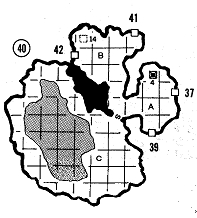
This area is divided into two cavern-like
chambers. Doors in sections A and B connect
to rooms 37, 39,
41,
and 42, while
secret doors join with areas 14
(above) and
4 (below).
One spot on the wall between A and C
has runes written in the stone; anyone who
attempts to read them will activate the
symbol
of insanity placed there. The symbol
may be dispelled normally. If a phase door
or passwall spell is cast upon this part of the
wall, a secret door will open into room C, a
large enclosed area containing a shallow
pool of water.
The pool functions in all ways as a mirror
of
opposition if anyone glances into it.
However, Baba Yaga is able to look into the
pool and call up a single duplicate of herself,
equally powerful in all respects, that
will function for one day before disintegrating.
Baba Yaga often uses these duplicates
to further her ends in other universes,
where they can accomplish a short mission
and then report back before falling apart.
Duplicates of Baba Yaga are completely
under her control, though there is no other
way to tell a duplicate from the real being.
41) Kitchens -- CH, 15? flat overall; IL,
see below.
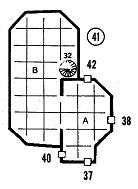
The fiery kitchens of Baba Yaga?s Hut are
manned by 3 annis servants (42,
44, and 47
HP) who labor constantly to produce
enough food to feed the Hut?s inhabitants.
Other annis servants stream in and out of
the kitchens, bringing foods to be cooked
and dinnerware to be washed. Careless
intruders in this area may wind up as a
dinner special; however, the cooks will
rarely bother anyone who simply passes by,
even if the visitor is obviously not a regular
inhabitant of the Hut.
Room A is kept reasonably clear of furniture
and loose items, so the annis won?t trip
on things when moving around. Doorways
here join with areas 37, 38, 40,
and 42. A
thick aroma of cooking meat may be detected
here at any time.
The kitchen itself is room B; the dim light
here comes from the wood-burning stoves
and a few candles on the shelves. A stairway
rises to area 32 from this room. Little treasure
may be found here, except what is
carried by the cooks themselves as protection
from flame (e.g., rings of fire resistance
or similar devices). A deadly array of cutlery,
ranging from knives to sword-sized
cleavers, lies around this area, and an angry
annis may be moved to hurl a pot full of
boiling water (can be thrown 30?, doing 3-
12 HP damage to all targets along a 10?
wide path).
42) Formal Dining Hall -- CH, 10? flat in
room A, 20? in room B; IL, 1 CL in room
A, see below for room B.
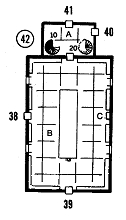
This area is divided into two rooms, a
small entry chamber that connects to areas
40 and 41, with stairs to 20
above and 10
below, and a large, formal dining hall that
connects to areas 38 and 39.
Room B is lined with bookcases, containing
volumes on mundane topics like politics,
geography of mythical worlds, etc. It is
lit by an enormous chandelier made from
yellow glassteeled glass, worth 10,000 gp,
but weighing seven hundred pounds. The
chandelier may be taken apart and reassembled,
but each process takes 7-12 hours.
Four false windows in the room have illusions
cast on them to make it appear that
the viewer is looking out over a pastoral
countryside from the dining hall, with
bright sunlight shining down and a gentle
breeze blowing through windows that are
half open.
One of the doors (C) in room B is a trap.
If opened, it appears to lead out into the
countryside, thanks to a permanent illusion
cast within it. However, anyone who steps
through the doorway will be destroyed
instantly as if he had walked into a sphere of
annihilation; no saving throw is allowed.
Only one chair sits at the huge dining
table here, obviously meant for Baba Yaga
herself. Anyone else who sits in this richly
furnished chair will be cursed (saving throw
vs. spells applicable) to want to go out
through door C to see the countryside.
43) Curio Rooms -- CH, 15? flat overall;
IL, 1 CL in each room A-D, none in E.
The Curio Rooms are four chambers (AD)
containing various animal and monster
skeletons that Baba Yaga has slain or gathered
from different planes and worlds. The
DM may decide which beasts are represented
here, and whether or not any of
them have magical powers from being
animated or being set up to serve as guardians.
Each chamber will contain 1-2 huge
skeletons and 3-6 smaller ones.
Doorways lead off to areas 44, 45,
and 47
from here, with stairways dropping to area
20 and rising to area 10. A secret
door,
normally detectable, is in room D; behind it
is a room in which assorted skeletons lie in
pieces or are boxed in crates. A door is set
in one wall of this room, but it leads nowhere.
Anyone who opens it will be struck
by a prismatic spray launched
from the
blank wall behind it.
44) Hall of Gateways -- CH, 20? flat
overall; IL, see below.
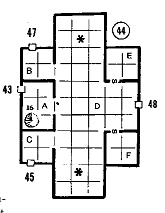
The doorways in this area connect directly
to areas 43, 45, 47,
and 48; a stairwell
climbs to area 16 from room A. All of
the walls, ceilings, and floors in this area
shine with a dull blue light, distorting normal
color vision considerably.
This area holds two magical gateways
that lead directly to the Outer Planes. The
gateway closest to rooms C and F will send
anyone walking upon it to Hades,
at a place
where a night hag colony resides. The other
gateway (near rooms B and E) may be
adjusted to connect with any plane desired;
all one has to do is speak the name of the
plane to be traveled to while standing on
the gate point (indicated by the asterisk
mark on the map). Up to four people at a
time may be transported to another plane.
Note that any Prime Material Plane may be
traveled to, as well as the Elemental Planes,
Ethereal Plane, Astral Plane,
and Positive
or Negative Material Plane.
Because of the open gateways, this area is
one in which all spells or powers labelled as
(P) above will function normally. The
guards kept here are among the most powerful
to be found in the Hut, and they will
attack anyone entering this area other than
a regular inhabitant of the Hut (unless the
visitor is escorted by Baba Yaga herself).
Two nycadaemons (111 and 129
HP) stay in
rooms E and F, each of which has a secret
door not detectable without magical means.
The walls between rooms D and E, and
between D and F, are constructed so that
anyone in E or F may see out into room D
but cannot be seen in turn. From within E
and F, the nycadaemons monitor those who
come and go. The daemons may enter or
leave their rooms at will, and will take
orders only from Baba Yaga.
45) Holding Room -- CH, 10? flat in A
and C, 20? in B; IL, 1 CL in A, 4 CL?s (one
in each corner) in B.
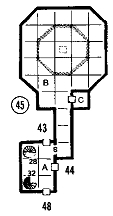
Room A appears to be nothing other than
a nexus point, with doorways going off to
areas 43, 44, and 48,
and stairways up to
area 28 and down to 32. A secret
door,
detectable by normal means, lies against
one wall of the room. The door has a magical
trap upon it that causes anyone attempting
to open it (other than Baba Yaga or her
?daughters?) to be struck deaf and blind
(save vs. spells at -4) permanently.
Room B is a holding area for summoned
beings that Baba Yaga or her associates wish
to study. A trap door in the ceiling (leading
to area 28, the Room of Conjuring) will
deposit the summoned being into a cage
made from walls of force in the shape of an
octagon. Vocal communication is possible
with trapped beings, though they cannot
escape unless a disintegrate spell is used
upon the walls. Once the study of a particular
creature is completed, a ritual summoning
is performed in area 28, causing the
creature to appear there once more, to be
sent back to the being?s home plane.
Usually no guardians patrol this area,
unless someone is studying something kept
down here. Often captured specimens are
left here by themselves; few have ever been
able to escape, however.
46) Control Room -- CH, 10? overall; IL,
see below

.
This tiny room is the control center for
the Hut. It looks rather unremarkable,
having a wooden ceiling and walls, and a
stony paved floor. In the middle of the room
is a 5? square rug, with no magical powers,
upon which Baba Yaga sits. Against one of
the six walls of this room is a large mirror
that completely covers the wall. Secret doors
in the ceiling and floor lead to areas 4 and
14, respectively.
When Baba Yaga is seated here, she can
command the mirror to look into any other
room in the Hut as if looking directly
through its walls. She can also command
the mirror to show her what the environment
outside the Hut looks like, and can
cause the mirror to transmit normal sounds
such as conversation along with the picture
it shows.
The Hut has several additional powers to
those mentioned earlier. It can be commanded
to plane shift once per day from
this room, by Baba Yaga alone, and can
teleport itself three times per day at her
command. Baba Yaga can make the Hut
attack or move as she wills it when concentrating
on the mirror. The Hut itself is not
sentient; it has a few ?programmed reflexes
? (such as against spheres of annihilation),
but cannot think for itself.
If anyone but Baba Yaga sits in this room
and attempts to control the Hut, he will be
stricken with a permanent feeblemind
spell
that can only be removed by a wish.
47) Guest Rooms 0-- CH, 15? flat overall;
IL, 1 CL (violet) centered in A, rooms B
and C are dark
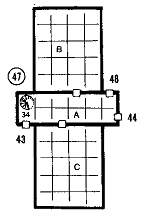
These two large rooms house daemons
and other monstrosities who are stopping
over in the Hut from the Lower Planes.
There is a 10% chance that one of the
rooms will be occupied; the DM may use
his discretion to determine what is present.
Doorways in the entry hall lead to areas
43, 44, and 48,
and a spiral stair rises to
area 34.
48) Servants? Quarters -- CH, 15? flat
overall; IL, dim light radiates from ceiling
(equivalent to a very cloudy day).
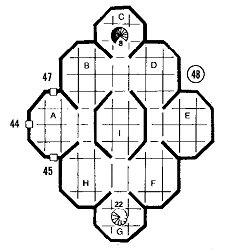
This area is the lair of five derghodaemons
(70, 76, 79, 85, and 91 HP) who
act as heavy guards and workers for Baba
Yaga; they obey her and no one else (though
they will not harm anyone else who is a
permanent resident of the Hut). These
daemons have littered the floor of their
room with trash, bones, and other debris;
anyone who moves about in here must roll
his dexterity or less on d20 in each round he
moves faster than 6?, or else fall down and
be unable to attack or defend himself for 1
round afterward.
The daemons have some treasure hidden
under the debris in several of the rooms,
which may be determined by the DM. Exits
lead off to areas 44, 45, and 47;
stairs rise to
area 22 and drop to area 8.
Acknowledgements
Special thanks to John Helle (?Put a
boalisk in there, those things are neat!?),
Jim Ward (How about a casino room run
by a night hag, where she?s got
this magic
roulette wheel . . .?), Penny Petticord (?I
always thought Baba Yaga had a nice personality
?), Chuck Ramsay (?Those Josef
Stalin tanks were pretty common back in
?43?, Roger Raupp (?I just don?t know
about the Russian tank; why not put an
aircraft carrier in the big lake, or a MiG-25
with big nukes all over it . . .?), Andria
Hayday (?It?s . . . interesting?), and Will
Lonergan (?It?s deviant?), whose help and
commentary made this module horrifying.
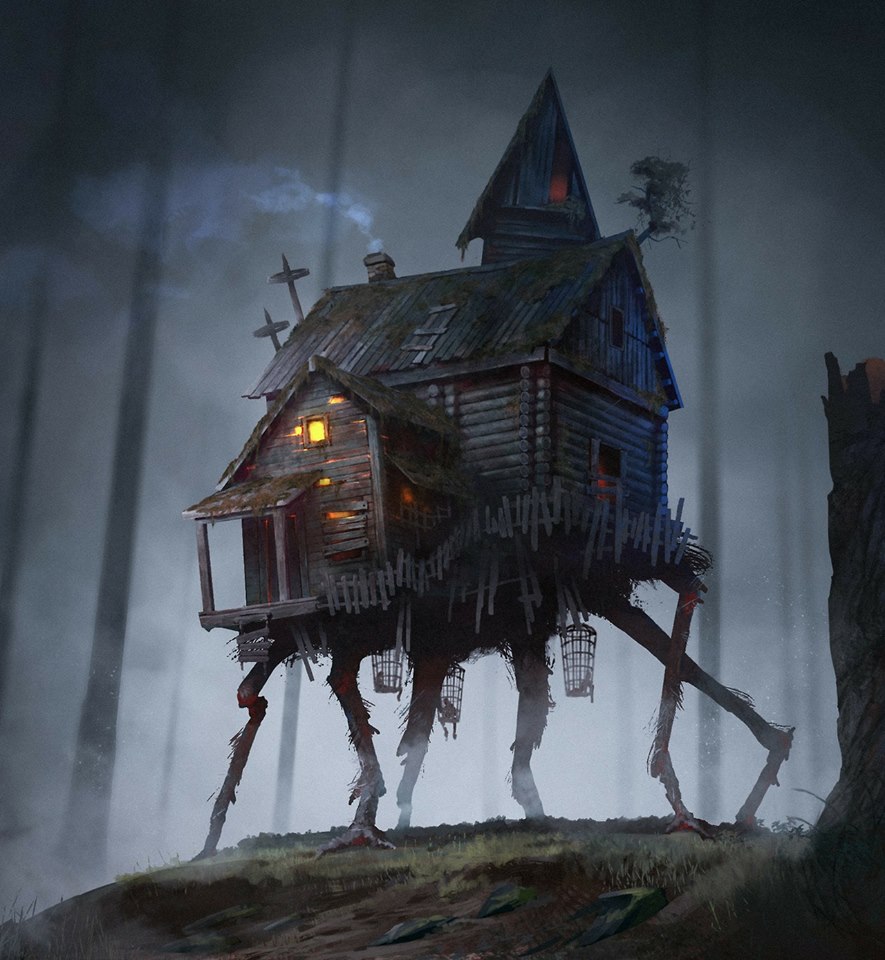
-
Hut, two, three
-
Dear Dragon,
I was impressed with "The Dancing Hut"
(issue #83), but was left with a few questions
after
reading it.
Where is the descriptive paragraph in the key
regarding room E in area 15? And, on the map to
area 21, where do G and H belong? For purposes
of determining the existence of the "chicken
track" brand, is a gem of seeing considered a
divinatory spell?
Rick Hartley
Bordentown, N.J.
(Dragon #85)
In room 21, the area of G is centered in the
20x20 space containing the staircase leading to
room 30. The space that should be marked H is
the other 20x20 area near door D. These letters
were mistakenly left off the map.
In room 15,
area E was purposely not detailed; there are
several other such places in the complex (in
rooms 17 and 24, for instance),
where spaces are
letter-keyed but not developed. These can be
"customized" by individual DMs, if so desired.
And yes, using a gem of seeing will brand a
character just like any other form of divinatory
magic.
-- KM
(Dragon #85)
-
Big, bad Baba Yaga
-
Dear Dragon,
I greatly enjoyed "The Dancing Hut" in #83.
But its version of Baba Yaga very much contradicted
the version in issue #76. For instance, in
#76 Baba Yaga has a strength of 22, but in the
#83 version she only has a strength of 20. I am
wondering why this happened.
Melvil Logan
Toronto, Ontario, Canada
(Dragon #90)
Dear Editor:
I thought "The Dancing Hut" by Roger
Moore in issue #83 was very well designed.
I can
only find two faults with it. First, in the introduction
Mr. Moore said that Baba Yaga is immune to
all magic and later he said that she cannot be hit
by any non-magical weapon. If that is true, then
she cannot be killed! The second flaw was that in
the DMG it says Baba
Yaga's Hut is worth only
90,000 g.p., but within Mr. Moore's Hut, Baba
Yaga's throne is of value beyond reason or counting
alone. Could you please clarify this for me?
Martin Stuart
Honolulu, Hawaii
(Dragon #90)
Several people have written in to say that the
Baba Yaga who was described in the "Dancing
Hut" module in #83 was not the same one
as
described in the Sage Advice column of issue #76.
Others have also noted that the "Dancing Hut"
is not like the Baba Yaga's
Hut described in the
DMG.
This was done on purpose. I knew a lot of
people would be familiar with the description of
the hut from the DMG, and I didn't want the
version in the module to resemble it too closely
This adds an element of surprise and freshness to
the module -- no one knows what to expect, and
this is as it should be. If your players knew from
the start what your dungeon was going to be like,
would you enjoy running them through it?
The descriptions of Baba Yaga and her hut
from other sources can be taken to be "rumors"
and "legends" told about them. If players have
read those descriptions, that's fine. They know
ahead of time that Baba Yaga is bad news and her
hut has many rooms inside it. But everything else
they know is wrong, which is how it goes with
rumors and legends if you put all your faith in
them. If some readers were particularly disturbed
that the hut and its owner were not like they had
been described, then they can alter the text as
they see fit. The module wasn't "official," if that
means anything to you.
I described the throne as being beyond value
(and this of course applies to the entire hut, too)
because I found it impossible to make even a
good estimate of what such a thing would be
worth. The hut described in the module is much
more detailed and more lavish than what the
DMG description seems to imply and its value
-- if such a thing could ever be determined --
would certainly exceed 90,000 gold pieces by an
incredible amount.
Finally, yes, Baba Yaga (as described in #83) is
pretty terrible. I made her that way on purpose.
Lots of people look for a challenging opponent
when their characters reach high levels, but find
none. Most high-level characters are also very
versatile and have many ways of attacking and
defending themselves. Baba Yaga is no exception,
and because she might often be pitted alone
against numerous opponents, I wanted to give
her a chance to make the player characters sweat
bullets. The Russian legends about her make her
pretty terrible to begin with.
I don't think it's a good idea for PCs to go after
Baba Yaga with the intention of slaying her,
which isn't easy to do anyway. (For the record,
the module did not say that Baba Yaga was
immune to all magic.) I have no idea what the
experience-point value for her would be if she
were slain. She works best as a long-playing NPC
who can show up to harass or assist characters
across a number of adventures, and perhaps even
different campaigns. Really powerful characters
like Baba Yaga, saints (as described
in issue #79), <Best of
Dragon 4>
or the quasi-deities of Greyhawk
(issue #71) can
serve as exciting encounters for high-level campaigns
to bring adventure, danger, and thrills
into the lives of powerful characters.
-- RM
(Dragon #90)